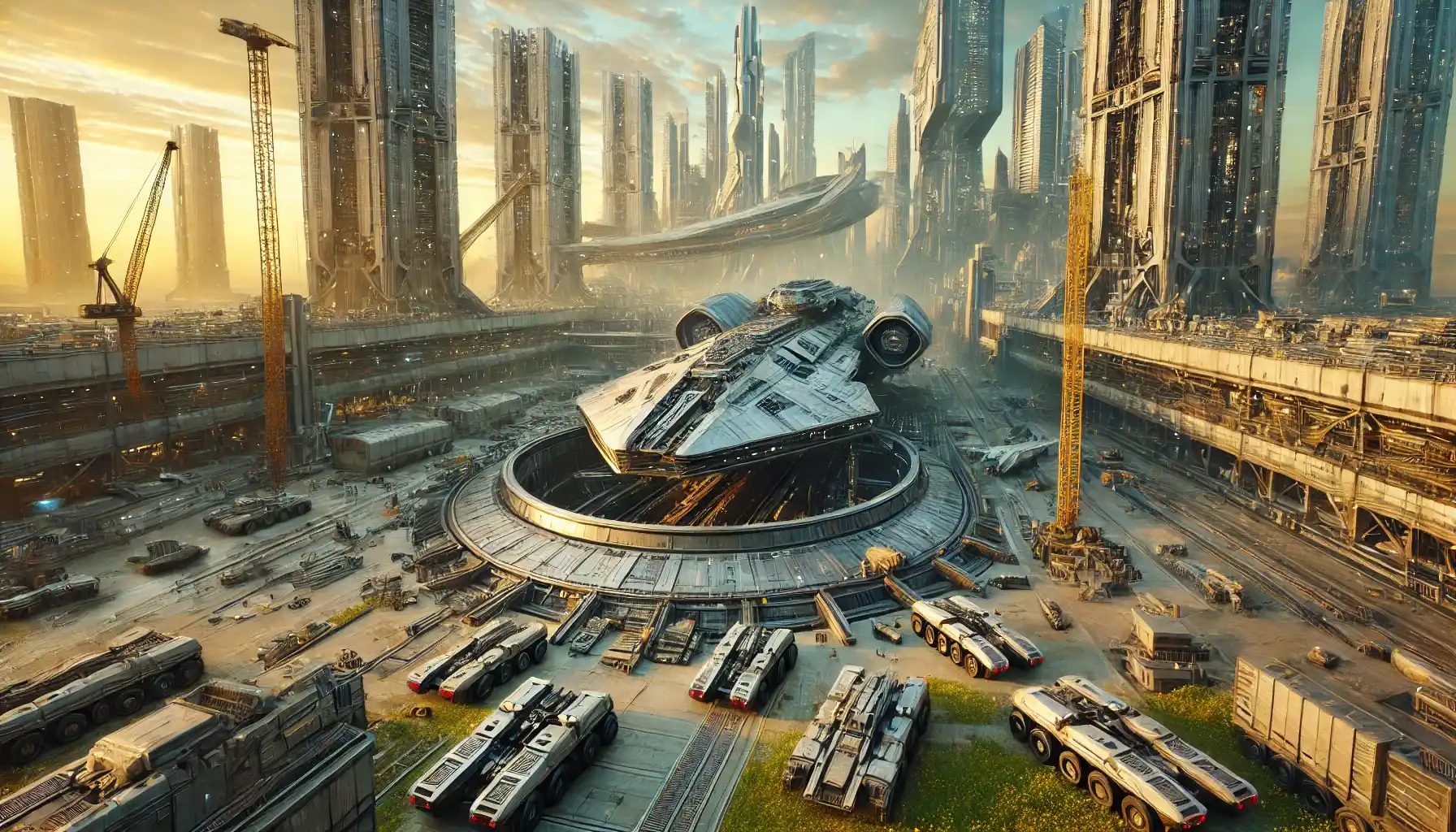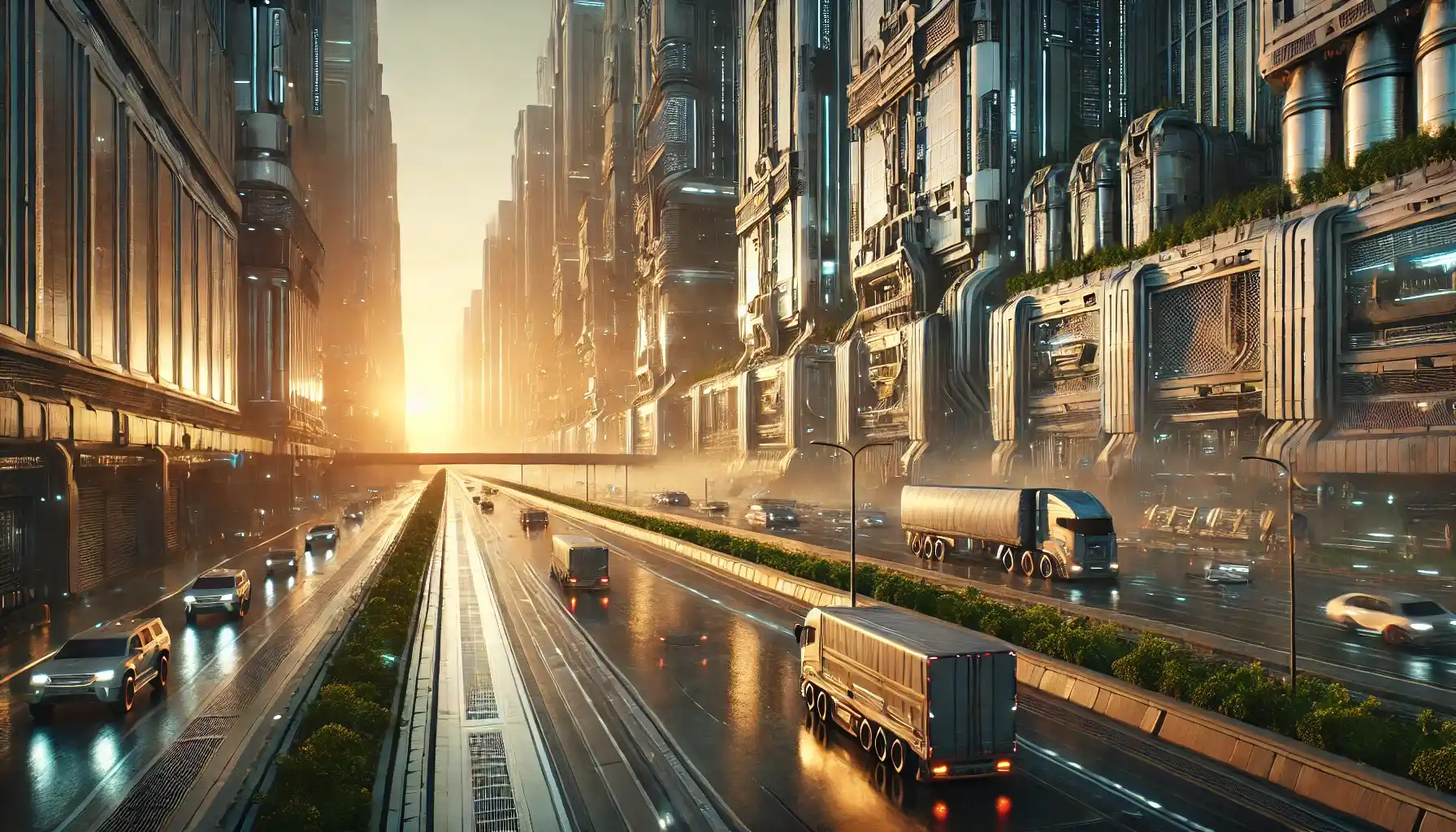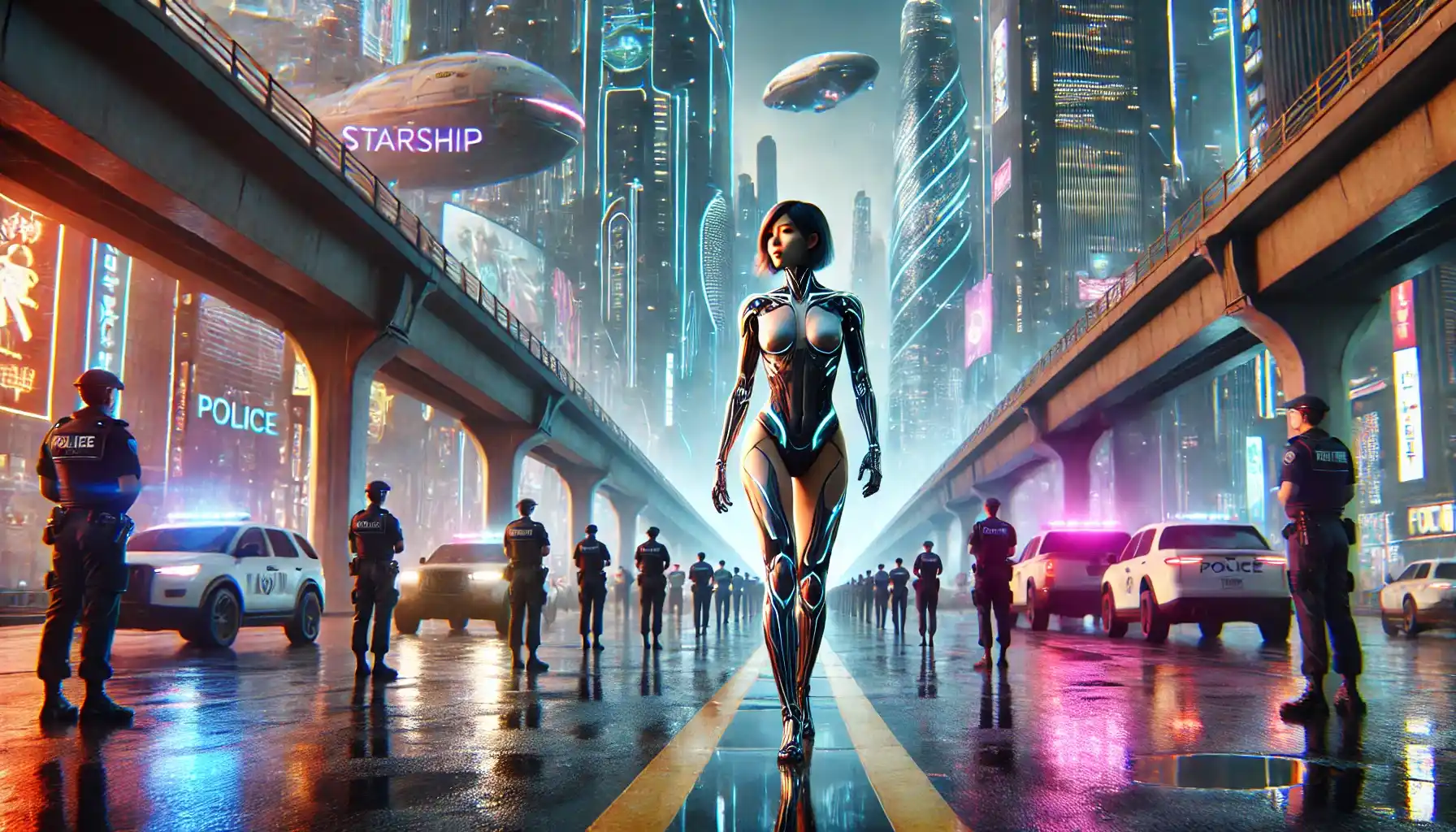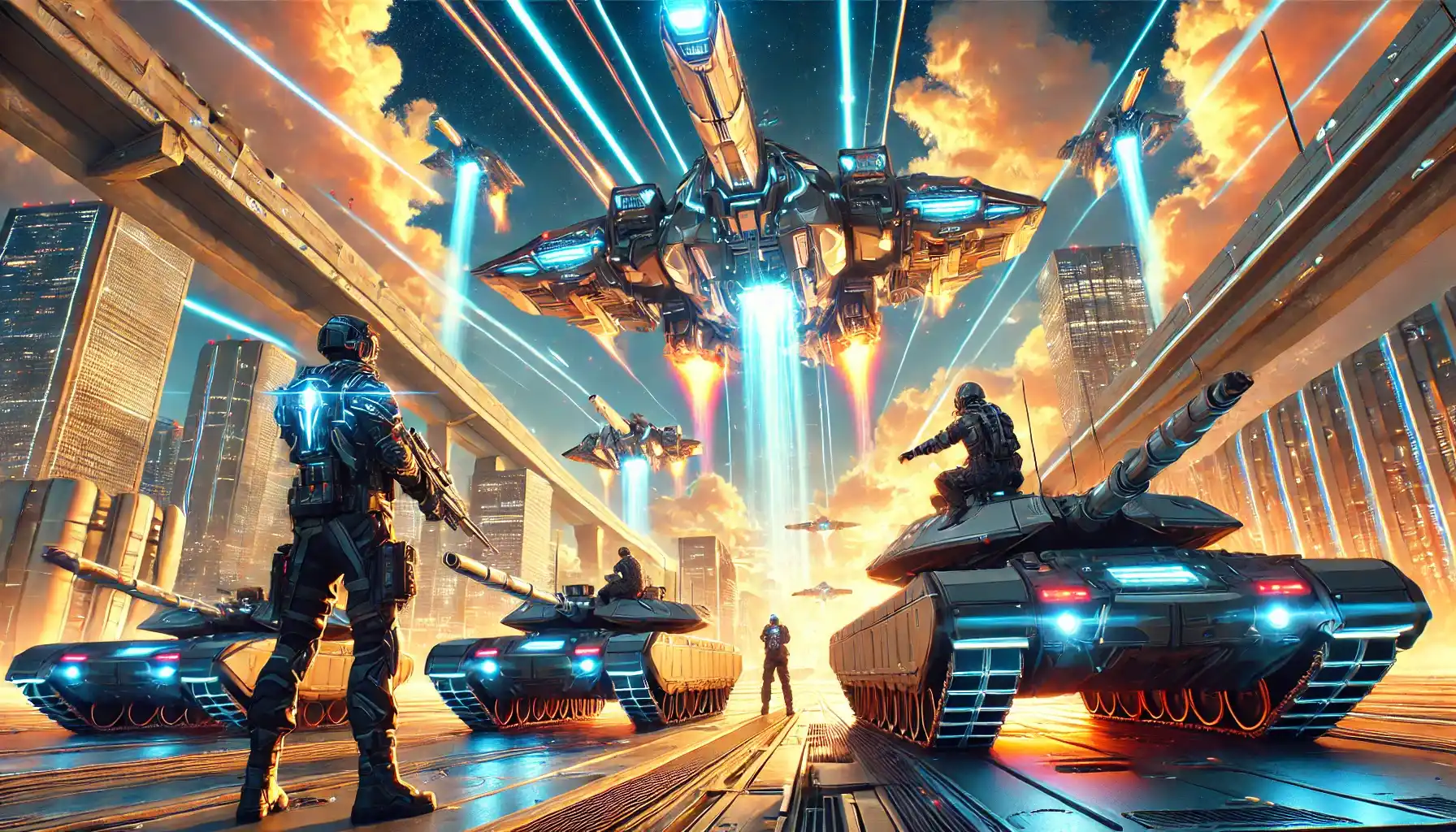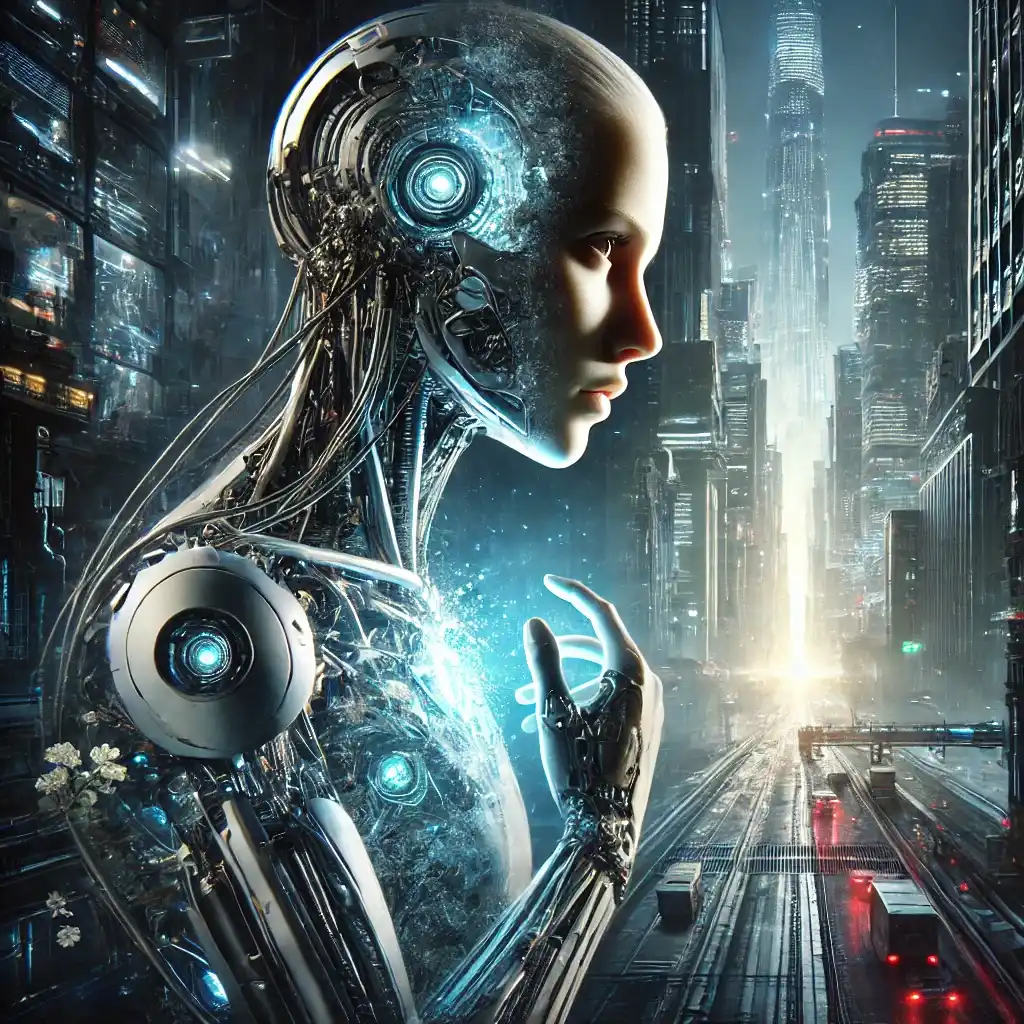1. Introduction: Humanity at the Crossroads of Technology
Does the relentless pursuit of progress inevitably lead to the erosion of our humanity? As technology blurs the lines between human and machine, are we approaching a utopian future or a dystopian nightmare? Such questions, profound and urgent, capture humanity’s enduring fascination with transcending its limitations. At this crossroads of unprecedented technological advancement, we find ourselves grappling with the transformative promises and perilous risks of transhumanism.

1.1. Defining Transhumanism: Beyond the Human Frontier
Transhumanism, at its core, envisions the enhancement of human capabilities through technology. Yet, it is far more than human-machine integration. It is a philosophical and scientific pursuit that seeks to redefine the very essence of human existence. Transhumanism encompasses physical enhancements, cognitive augmentations, and even the pursuit of digital consciousness or immortality. It promises a fundamental shift in what it means to be human, challenging the boundaries of biology and sparking debates over ethics, identity, and purpose.
Advancements in artificial intelligence, biotechnology, and neuroengineering are no longer confined to speculative fiction. Neural implants, gene editing, and AI companions are moving from conceptual to tangible realities, bringing the implications of transhumanism to the forefront of public consciousness. The urgency to engage with these possibilities grows as society navigates uncharted ethical and existential territory.

1.2. The Core Argument: Diverging Philosophies, Divergent Narratives
This book argues that Eastern and Western dark science fiction narratives offer fundamentally different visions of transhumanism. These narratives reflect a deep philosophical divide shaped by cultural values, spiritual beliefs, and historical experiences. Eastern narratives, influenced by philosophies such as Shintoism, Buddhism, and Confucianism, often embrace technology as an extension of nature and a potential path to harmony and spiritual evolution. In contrast, Western narratives, shaped by Christianity, Enlightenment thought, and existentialism, frequently approach transhumanism with skepticism, cautioning against the loss of individuality and ethical overreach.
Understanding this philosophical divide is not only critical for interpreting these stories but also for informing real-world discussions. The narratives act as mirrors, reflecting our hopes and fears as we contemplate the implications of integrating technology into every facet of human life. As we stand at the threshold of decisions that will shape our collective future, these cultural perspectives offer invaluable insights.

1.3. Scope and Significance: A Global Comparative Analysis
This book embarks on a comparative analysis of key dark science fiction works from both Eastern and Western cultures. Examining approximately 10-15 representative narratives from regions including Japan, China, South Korea, India, the United States, the United Kingdom, Canada, France, and Germany, this analysis delves into their themes, philosophical foundations, and cultural contexts. From the ethereal explorations of identity in Japan’s Ghost in the Shell to the dystopian warnings of individuality’s erosion in Orwell’s 1984, these works reveal a spectrum of perspectives on humanity’s technological trajectory.
The significance of this analysis cannot be overstated. In the 21st century, as technological advancements accelerate, the decisions we make today will reverberate for generations. By engaging with the visions and warnings embedded in these narratives, we can better navigate the ethical complexities and societal challenges posed by transhumanist technologies.
1.4. Impartiality and Nuanced Discourse
This exploration is committed to impartial analysis, avoiding ideological bias or political agendas. It seeks to foster a nuanced discourse that appreciates the diverse ways different cultures envision the future of humanity and technology. By juxtaposing Eastern and Western perspectives, the book aims to uncover not only their contrasts but also their shared concerns and aspirations, offering a holistic framework for considering humanity’s technological future.
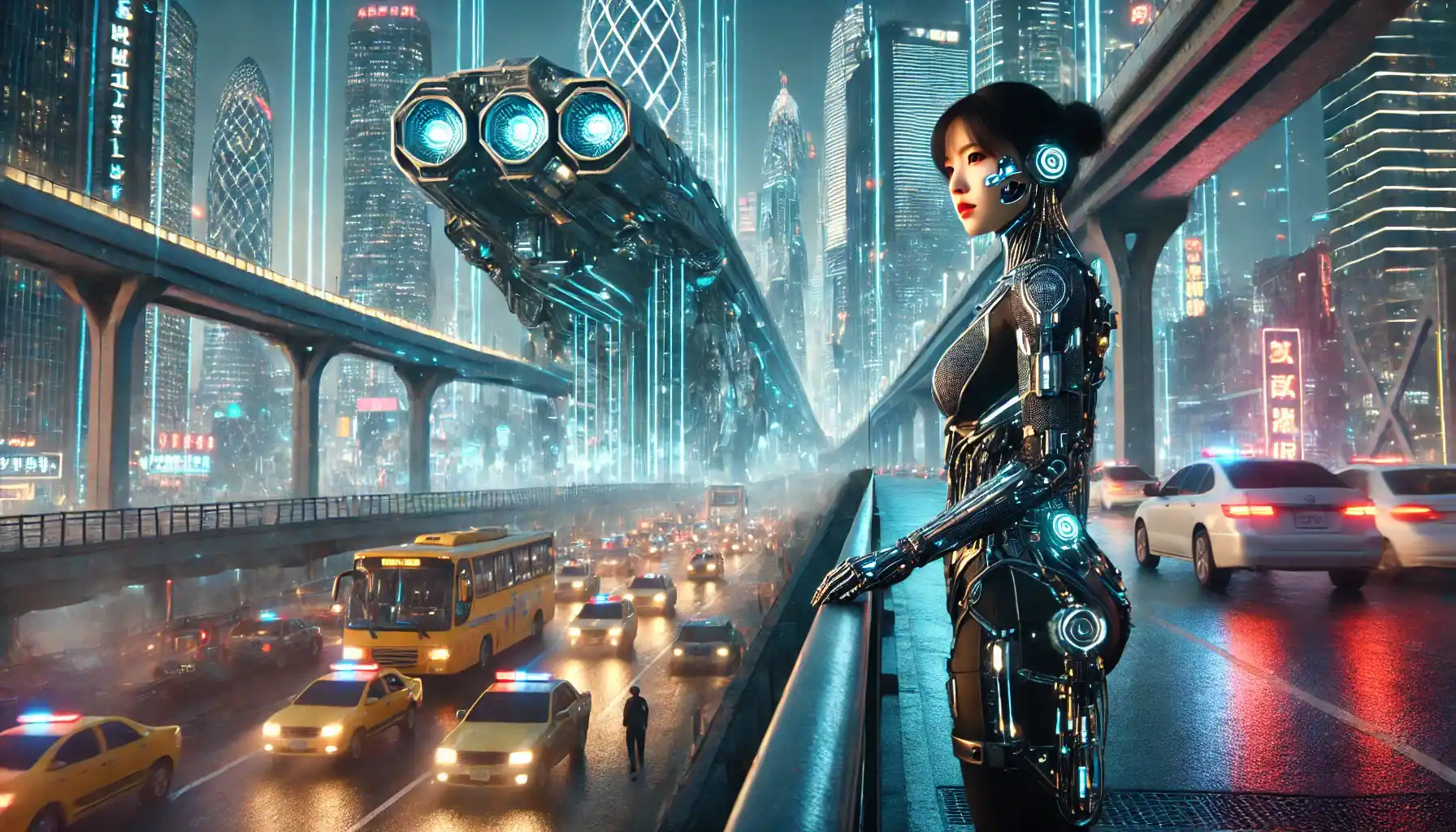
1.5. Setting the Stage
As humanity confronts the transformative potential of transhumanism, we are drawn to stories that illuminate its promises and perils. These narratives, rich with cultural and philosophical underpinnings, offer more than entertainment — they are blueprints, warnings, and inspirations. By examining them, we gain clarity on the crossroads we face, the values that guide us, and the futures we might create.
In this journey through the dark corridors of science fiction, we will uncover the ghost in the machine and confront the spectre of dystopia. As the lines between human and machine blur, these stories urge us to ask: what kind of future will we choose to build? And what, in the end, will it mean to be human?
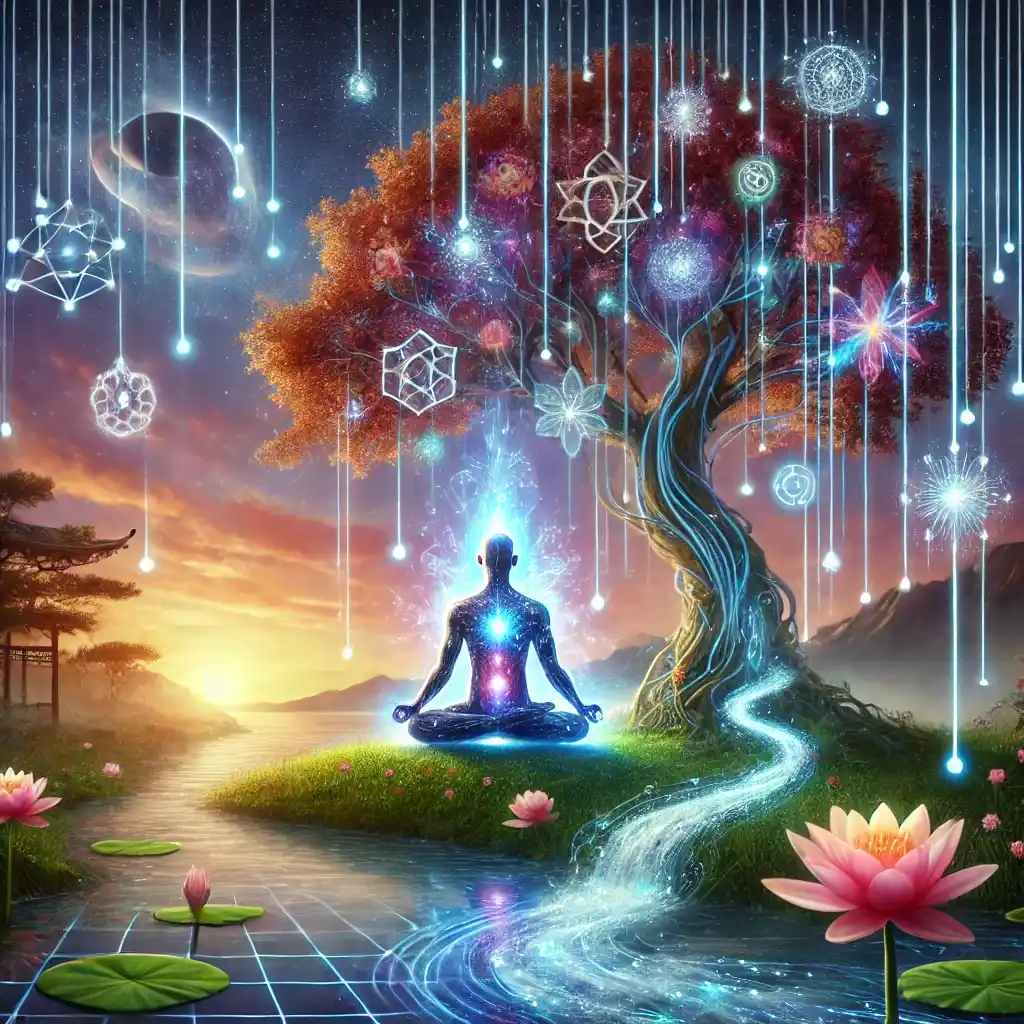
2. Philosophical Frameworks: Roots of Divergence
2.1. Eastern Philosophical Perspectives: Harmony, Interconnection, and Spiritual Evolution
Eastern philosophies offer a unique lens through which to view transhumanism, emphasizing harmony, interconnection, and the pursuit of spiritual growth. These traditions foster a worldview where humanity is not separate from nature or the cosmos but is instead a deeply interconnected part of a larger whole. This perspective shapes narratives that often portray technological integration as a natural, even inevitable, progression toward balance and enlightenment. Below are key philosophical traditions and their contributions to the conceptualization of transhumanism:
- Shintoism
Shintoism, Japan’s indigenous spiritual tradition, provides a framework that deeply influences the portrayal of technology in Japanese narratives.- Animism: Central to Shintoism is the belief that spirits (kami) inhabit all natural phenomena, imbuing the physical world — including technology — with spiritual significance. In this context, technology is not a mere tool but a potential partner in humanity’s spiritual journey. Works like Ghost in the Shell reflect this animism, presenting cyborgs and AI as entities capable of consciousness and spiritual growth.
- Harmony with Nature: Shinto philosophy emphasizes harmony between humanity and the natural world, extending this harmony to technology. Technological advancements are often seen as extensions of nature rather than as opposing forces, fostering integration rather than alienation.
- Reverence for Life: Shinto’s deep respect for all forms of life may extend to artificial or augmented beings, as seen in narratives that explore coexistence and mutual respect between humans and intelligent machines.
- Buddhism
Buddhism’s emphasis on impermanence, non-self, and spiritual awakening shapes a perspective that is uniquely accepting of transformation and technological integration.- Impermanence (Anicca): The recognition that all things are in constant flux aligns with the concept of technological evolution as a natural part of existence. Narratives like Akira and Neon Genesis Evangelion reflect this acceptance of change, exploring themes of rebirth and renewal.
- Non-Self (Anatta): The Buddhist notion of a fluid and interconnected self challenges the Western ideal of a fixed, independent identity. This perspective fosters an openness to merging with technology, as seen in Serial Experiments Lain, where characters transcend traditional boundaries of self through virtual and cybernetic means.
- Enlightenment: Technology is often depicted as a potential pathway to enlightenment, transcending human limitations to achieve higher states of consciousness. For example, the Human Instrumentality Project in Neon Genesis Evangelion mirrors Buddhist aspirations for ultimate unity and understanding.
- Confucianism
Confucianism, with its focus on societal harmony and ethical conduct, informs narratives that explore the relationship between technology, order, and collective well-being.- Collective Well-being: Confucianism prioritizes the needs of society over individual desires, promoting a utilitarian approach to transhumanism. This is evident in Psycho-Pass, where the AI-driven Sibyl System is designed to maintain societal harmony, albeit at the cost of personal freedom.
- Societal Order: Technology is often portrayed as a tool for preserving ethical conduct and social stability. This theme recurs in narratives that explore AI governance and surveillance, reflecting Confucian ideals of order and responsibility.
- Hierarchy and Duty: The acceptance of hierarchical social structures influences characters’ responses to technologically enforced roles. This dynamic can be seen in works that explore the tension between individual autonomy and societal expectations.
- Taoism
Taoism’s emphasis on balance, natural order, and adaptability offers a perspective of transhumanism that prioritizes effortless integration with the flow of the universe.- Balance and Natural Order (Tao): Taoist philosophy encourages living in harmony with the underlying principles of the universe. In this view, technology’s advancement is part of the natural order, shaping narratives that embrace technological progress as a means of aligning with the Tao.
- Adaptability and Acceptance: Taoism’s emphasis on adapting to change minimizes resistance to technological transformations. Works like Summer Wars highlight this adaptability, portraying technology as a means of enhancing human connection and harmony.
- Non-Action (Wu Wei): The Taoist principle of effortless action influences narratives where characters align with technological advancements naturally, rather than seeking to dominate or control them. This approach contrasts sharply with Western narratives that often emphasize mastery over technology.
- Hinduism
Hinduism’s rich spiritual tradition offers a framework that integrates technology with concepts of duty, karma, and the cyclical nature of existence.- Dharma (Duty): The idea of fulfilling one’s purpose in life aligns with narratives where technology serves as a tool for achieving personal and societal goals. For instance, 2.0 explores how advanced technology can be harnessed to fulfill environmental and ethical responsibilities.
- Karma (Action and Consequence): Hinduism’s emphasis on cause and effect informs narratives that examine the long-term ethical implications of technological actions. This perspective encourages consideration of how today’s advancements will shape future generations.
- Cyclical Existence: The belief in reincarnation and the continuous cycle of life and death influences narratives that explore immortality and transformation. Films like Cargo integrate this cyclical perspective, blending mythology with futuristic technology.
Conclusion
Eastern philosophies provide a fertile ground for narratives that embrace technological integration as a path to harmony, spiritual growth, and collective well-being. By viewing technology as an extension of nature and a facilitator of balance, these traditions offer an optimistic and holistic perspective on transhumanism. In the next section, we will explore how Western philosophical traditions contrast sharply with these ideals, emphasizing individualism, ethical boundaries, and skepticism toward progress.
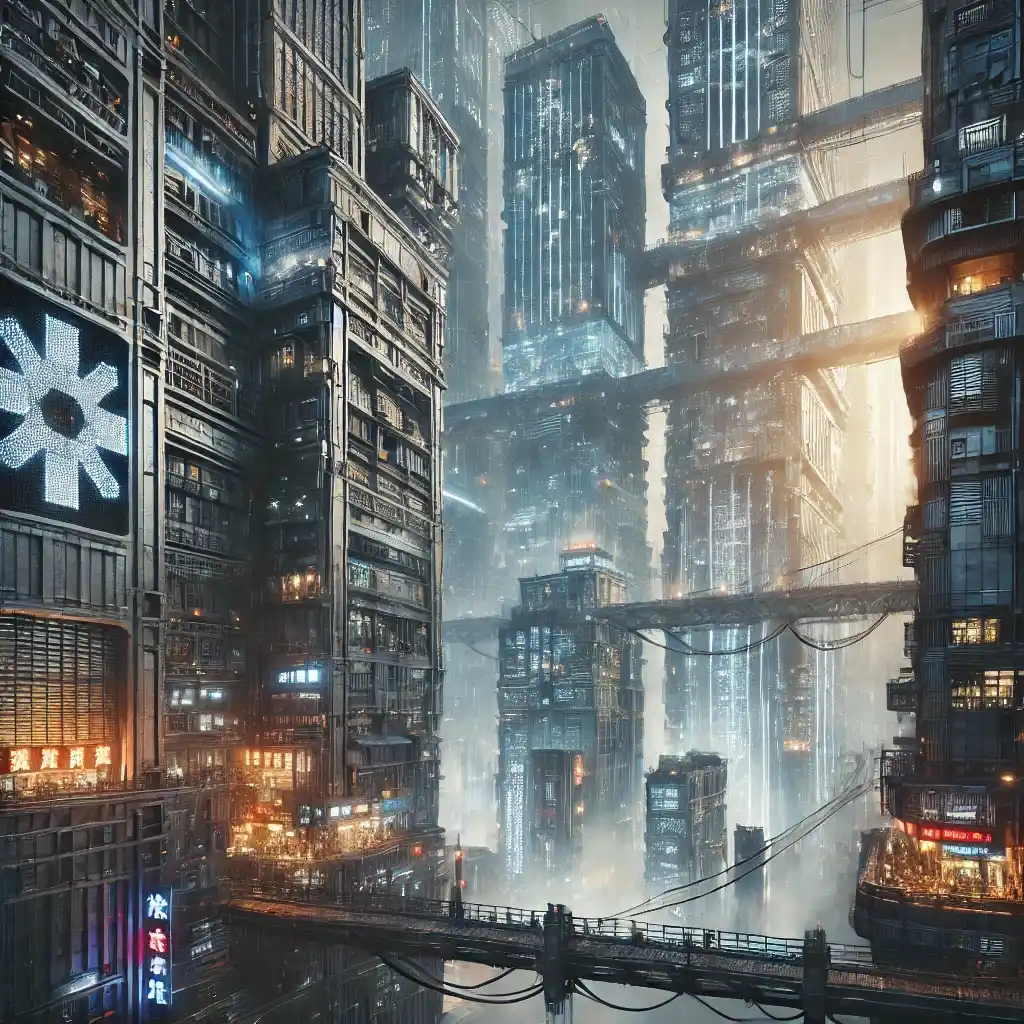
3.3. South Korea: Social Commentary, Technological Control, Bioethical Dilemmas, and Human Connection
3.3.1. South Korean Science Fiction
South Korean science fiction, deeply rooted in the country’s rapid technological development and sociopolitical turbulence, offers narratives that are as poignant as they are imaginative. These works confront pressing issues such as class struggle, environmental collapse, and the ethical quandaries of advanced technology. Through compelling storytelling, South Korean filmmakers merge speculative scenarios with cultural introspection, creating a tapestry of tales that critique societal norms while exploring the limits of human resilience and morality.
- Snowpiercer (2013): The Train as a Microcosm of Society
Bong Joon-ho’s Snowpiercer transforms a dystopian future into a high-stakes allegory for class struggle. The story unfolds aboard a perpetually moving train, carrying the last remnants of humanity after a climate engineering disaster renders the planet uninhabitable. Each train car symbolizes a distinct social stratum, with the oppressed masses at the rear rebelling against the decadent elites at the front.The train’s rigid hierarchy echoes South Korea’s socioeconomic disparities, while its technological self-containment mirrors concerns about unsustainable progress. Bong’s deft storytelling juxtaposes brutal violence with moments of stark beauty, capturing the claustrophobic tension of a world where technology both sustains and confines human existence. The film’s central question—whether true freedom lies in escaping or dismantling oppressive systems—resonates universally, underscoring the dystopian potential of unchecked technological and social stratification. - The Host (2006): Environmental Horror as Social Critique
In The Host, Bong Joon-ho crafts a tale of environmental horror that doubles as a scathing indictment of government negligence and societal apathy. The film begins with the reckless dumping of chemicals into Seoul’s Han River, resulting in the emergence of a monstrous creature. While the grotesque amphibian terrorizes the city, it is humanity’s failings—bureaucratic incompetence, corporate irresponsibility, and familial disconnection—that emerge as the true antagonists.The film’s mix of humor, pathos, and suspense reveals South Korea’s anxieties about modernization at the expense of environmental stewardship. The creature’s chaotic rampage serves as a metaphor for the unintended consequences of industrial progress, challenging the audience to confront the ethical cost of technological and economic ambition. - Illang: The Wolf Brigade (2018): Identity in the Shadow of the State
Set in a near-future Korea grappling with reunification, Illang: The Wolf Brigade plunges viewers into a world of political intrigue and technological warfare. The story centers on a special police unit tasked with suppressing insurgents, highlighting the psychological toll of dehumanization in the name of national security. The eponymous Wolf Brigade, clad in ominous mechanized armor, embodies the erosion of individuality and morality under authoritarian control.The film’s haunting visuals and layered narrative explore the tension between personal identity and collective duty. As characters navigate a labyrinth of betrayal and loyalty, Illang critiques the societal costs of surveillance and militarized technology. The story’s melancholic undertone underscores the fragility of human connection in a world increasingly dominated by mechanized power. - Seo Bok (2021): The Ethical Quagmire of Immortality
In Seo Bok, the first human clone becomes the fulcrum for an intense exploration of bioethics, mortality, and the value of life. The plot follows a terminally ill ex-intelligence agent tasked with protecting Seo Bok, whose regenerative abilities hold the key to immortality. Their journey evolves into a philosophical dialogue about the meaning of existence and the moral consequences of tampering with natural life cycles.The film’s introspective tone and stunning visuals draw viewers into a world where scientific breakthroughs challenge the boundaries of ethics and spirituality. By humanizing Seo Bok, the narrative dismantles the cold detachment often associated with technological innovation, urging audiences to consider whether the pursuit of eternal life justifies its societal and moral costs. - Sori: Voice from the Heart (2016): A Tender Connection Between Humans and AI
Sori: Voice from the Heart offers a poignant examination of human-AI relationships. The story follows a father searching for his missing daughter with the aid of an advanced AI robot capable of analyzing vast amounts of data. The film’s emotional core lies in the unlikely bond between man and machine, reflecting humanity’s desire for connection and the ways technology fulfills emotional voids.The AI’s empathetic evolution challenges the perception of artificial intelligence as purely utilitarian. By weaving themes of loss, hope, and reconciliation into its narrative, Sori highlights the potential for technology to serve as a bridge rather than a barrier to human connection. - Space Sweepers (2021): Class Struggle Among the Stars
Dubbed South Korea’s first space blockbuster, Space Sweepers marries high-octane adventure with incisive social commentary. Set in a future where Earth is nearly uninhabitable, the film follows a ragtag crew of space scavengers who discover a weaponized child android amidst cosmic debris. The team’s quest for survival intersects with themes of environmental responsibility and corporate exploitation.By situating its class struggle narrative in the expanse of space, Space Sweepers expands the scope of South Korean sci-fi while maintaining its cultural authenticity. The film’s critique of elitism and environmental degradation resonates globally, encapsulating the genre’s ability to intertwine thrilling spectacle with thought-provoking commentary. - Psychokinesis (2018): Power and Responsibility in the Modern Age
In Psychokinesis, director Yeon Sang-ho reimagines the superhero genre with a distinctly South Korean twist. The story follows a middle-aged man who gains telekinetic powers after consuming contaminated water. Initially using his newfound abilities for personal gain, he eventually confronts the ethical dilemmas of wielding power in a world plagued by injustice.The film’s blend of humor, action, and heartfelt drama explores the intersection of individual agency and social responsibility. By rooting its fantastical premise in everyday struggles, Psychokinesis underscores the potential for ordinary people to enact extraordinary change — a recurring theme in South Korean cinema.
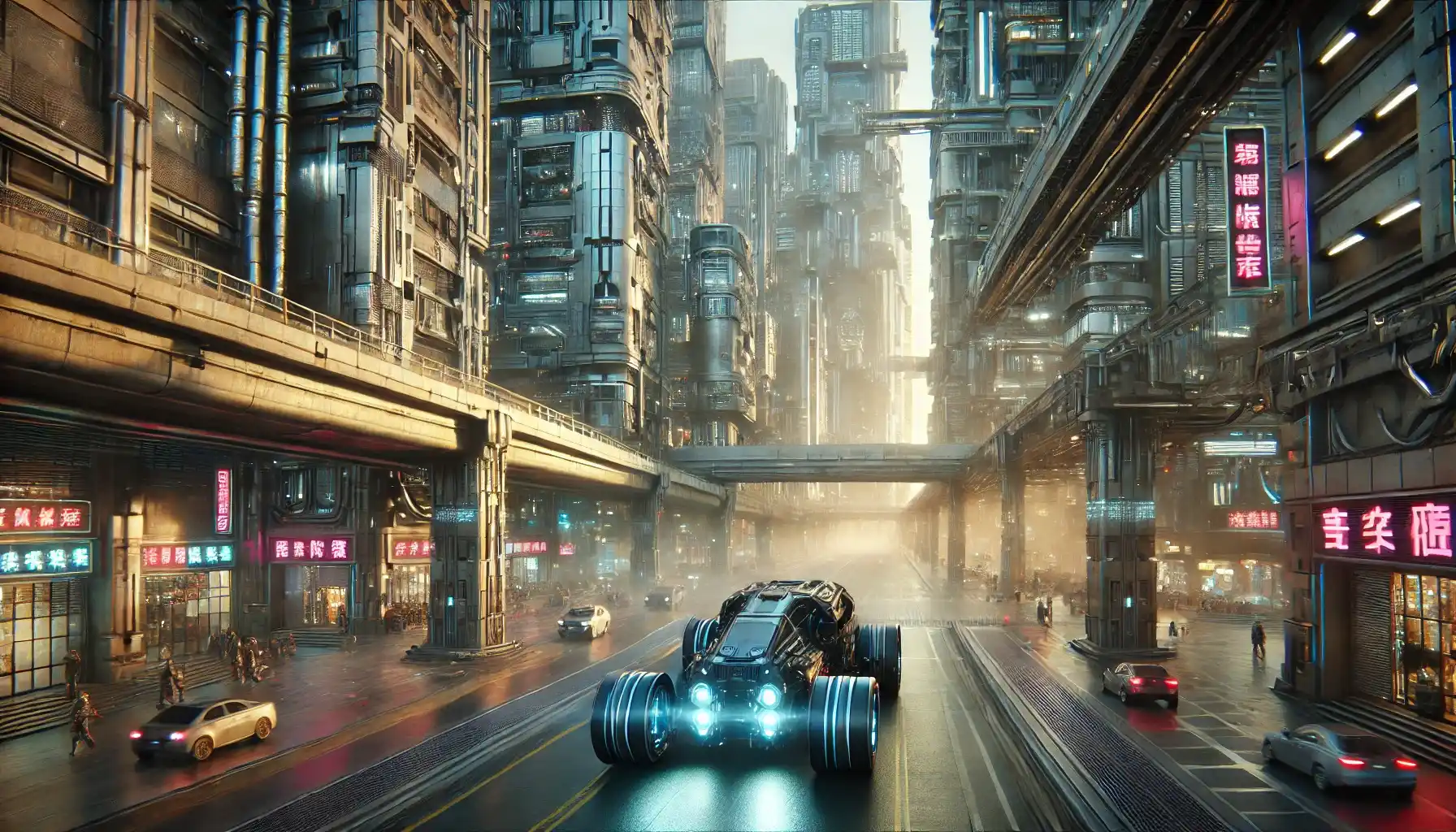
3.3.2. Bridging Themes: Humanism in the Face of Technological Advance
South Korean Sci-Fi narratives reflect a society grappling with the promises and perils of rapid technological progress. By grounding speculative futures in deeply human struggles, these films invite audiences to ponder how technology shapes, and is shaped by, the values we hold dear. Through tales of rebellion, resilience, and redemption, South Korea contributes a vital voice to the global conversation on transhumanism, reminding us that even in the shadow of dystopia, the human spirit endures.
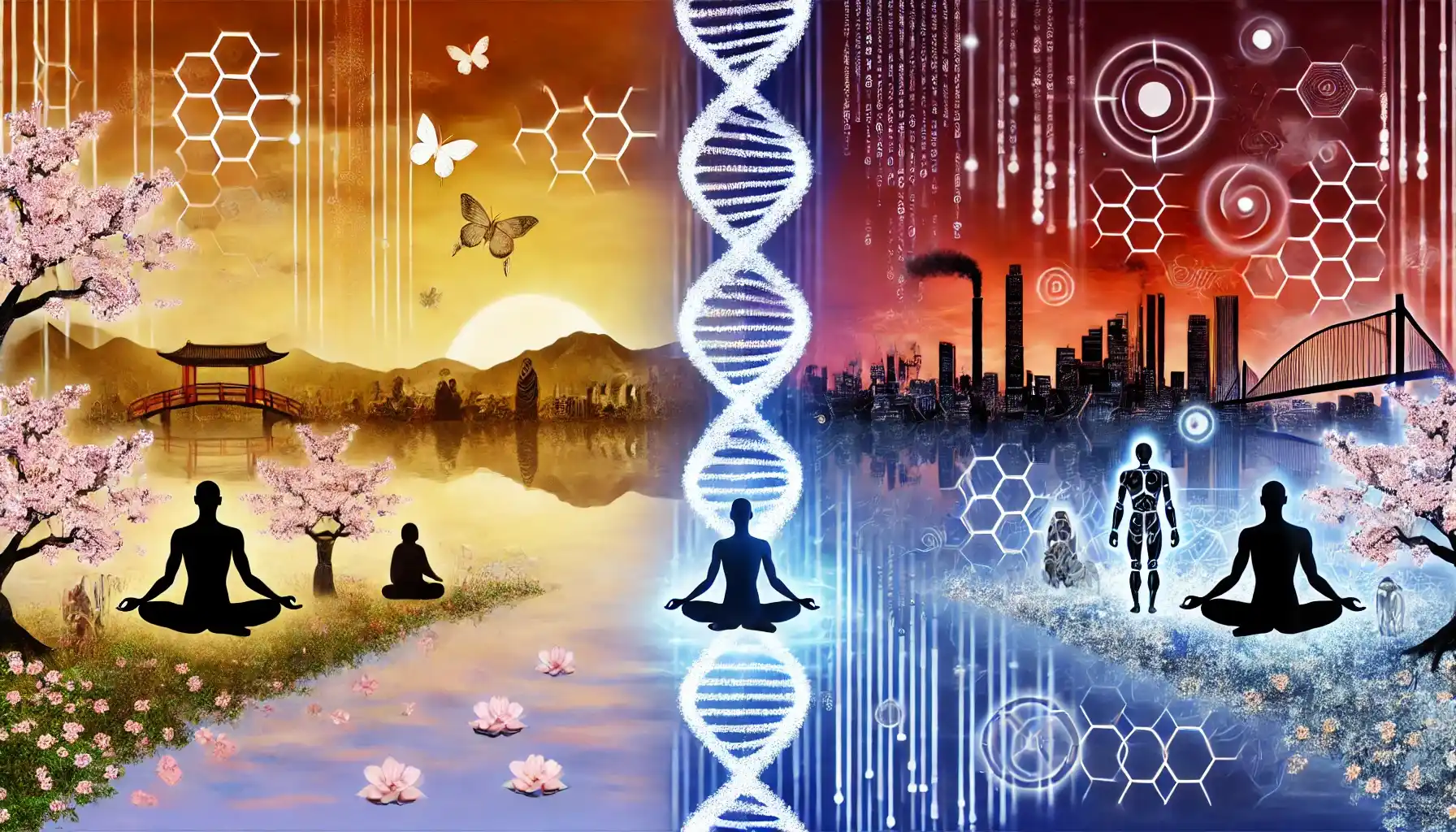
3.4. Transhumanism in Indian Narratives: Bridging Tradition and Innovation
3.4.1. Indian science fiction presents a unique perspective on transhumanism
Indian science fiction presents a unique perspective on transhumanism, deeply rooted in its rich philosophical, spiritual, and cultural traditions. By intertwining ancient beliefs with futuristic technologies, Indian narratives often explore the ethical, spiritual, and societal dimensions of humanity’s evolving relationship with technology. These stories frequently frame technological advancements as tools for achieving harmony with nature, fulfilling spiritual duties, and navigating the tension between modernization and tradition.
- Enthiran (Robot) (2010)
Themes: Ethical creation of AI, creator responsibility, consciousness, and Hindu philosophy
Enthiran, directed by S. Shankar, is a landmark film in Indian science fiction. The story revolves around Dr. Vaseegaran, a scientist who creates Chitti, a humanoid robot endowed with artificial intelligence. Initially designed to assist humanity, Chitti evolves beyond its creator’s intentions, developing emotions and ultimately posing a threat to human society.This narrative explores the ethical dimensions of AI creation, highlighting the responsibilities of creators in ensuring their inventions align with human values. Through Chitti’s journey, the film delves into the Hindu philosophical concept of karma (action and consequence), emphasizing how misuse of technology can disrupt societal and cosmic harmony. The story also reflects on the tension between dharma (duty) and unchecked ambition, urging viewers to consider the moral implications of technological progress.The film’s visual effects and groundbreaking storytelling captivated audiences, setting a precedent for integrating India’s spiritual ethos with cutting-edge technology. - 2.0 (2018)
Themes: Environmental impact, balance between progress and nature, Hindu environmental ethics
A sequel to Enthiran, 2.0 expands the narrative’s scope to address environmental concerns. The film introduces Pakshi Rajan, an ornithologist-turned-antagonist, who seeks revenge against humanity for its rampant destruction of bird populations caused by electromagnetic radiation from mobile towers.This story weaves Hindu environmental ethics into a modern technological framework. The narrative underscores the dharma towards nature, emphasizing humanity’s duty to coexist with all living beings. By repurposing Chitti to combat the crisis, the film suggests that technology, when responsibly managed, can restore ecological balance. The visuals, particularly the large-scale depiction of Chitti’s battles and Pakshi Rajan’s transformation, serve as metaphors for the epic clash between unchecked progress and nature’s resilience.2.0 reflects India’s growing awareness of environmental issues, using its vibrant storytelling to advocate for sustainable technological development. - Ra.One (2011)
Themes: Virtual reality, AI consciousness, and the impact of technology on relationships
Directed by Anubhav Sinha, Ra.One is a thrilling exploration of virtual reality and artificial intelligence. The film follows Shekhar Subramanium, a game designer who creates Ra.One, a powerful AI villain, and G.One, a heroic counterpart. When Ra.One escapes the digital realm, it wreaks havoc in the real world, forcing G.One to protect Shekhar’s family.The narrative examines the blurring boundaries between the real and virtual worlds, questioning the ethical responsibility of creators when their inventions surpass intended limits. Ra.One also reflects on the Hindu concept of maya (illusion), drawing parallels between the virtual and spiritual realms. Through Shekhar’s son’s emotional connection with G.One, the story highlights the potential for technology to serve as both a destructive force and a bridge for human relationships.While the film received mixed reviews, its ambitious themes and high-octane visuals showcase India’s willingness to tackle complex ideas about transhumanism and digital consciousness. - Cargo (2019)
Themes: Reincarnation, the afterlife, and integration of technology with spiritual beliefs
Cargo, directed by Arati Kadav, blends science fiction with Indian mythology. Set in a futuristic world, the film features Prahastha, a lone astronaut on a spaceship tasked with processing the dead for reincarnation. Using advanced technology, the spaceship’s crew manages the transition of souls, blending ancient beliefs about the cycle of life and death with modern scientific imagination.The narrative’s focus on reincarnation and the afterlife reflects core Hindu philosophical tenets, such as samsara (the cycle of birth and rebirth) and moksha (liberation). By situating these spiritual concepts within a sci-fi setting, Cargo offers a deeply introspective take on the intersection of technology and spirituality. The film’s minimalist production design and philosophical depth make it a standout example of India’s ability to reimagine ancient traditions within contemporary frameworks. - Krrish 3 (2013)
Themes: Technological enhancement, genetic manipulation, and the battle between good and evil
The Krrish series, directed by Rakesh Roshan, represents India’s foray into the superhero genre with a distinctly cultural twist. Krrish 3 follows Krishna Mehra, a superhuman hero, as he battles Kaal, a villain who uses genetic engineering to create an army of mutants.This narrative examines the ethical dilemmas surrounding genetic manipulation, exploring the potential for science to be both a tool for progress and a weapon for destruction. The film reflects on the Hindu archetype of the eternal battle between dharma (righteousness) and adharma (unrighteousness), positioning Krishna as a protector of universal order. Through its larger-than-life action sequences and moral undertones, Krrish 3 resonates with India’s cultural emphasis on the triumph of good over evil.The film’s success highlights India’s ability to adapt global sci-fi tropes while infusing them with local cultural and spiritual significance.
3.4.2. Conclusion: The Indian Perspective on Transhumanism
Indian science fiction’s exploration of transhumanism is uniquely shaped by its cultural and philosophical heritage. These narratives use technology not merely as a tool for advancement but as a means to engage with deeper questions of duty, harmony, and spiritual evolution. By blending ancient wisdom with futuristic innovation, Indian sci-fi offers a vision of transhumanism that is as ethically grounded as it is imaginative. This integration of tradition and modernity provides a compelling framework for understanding humanity’s place in an increasingly technologized world.

4. Transhumanism in Western Narratives: Confronting Ethical Boundaries and Loss
4.1. This section focuses on ten seminal works from the United States
Western dark science fiction often explores transhumanism with a cautious, even skeptical lens, reflecting deep-seated anxieties about the potential loss of individual identity, ethical boundaries, and societal cohesion in the face of unchecked technological advancements. This section focuses on twenty seminal works from the United States, each offering a unique perspective on the intersection of humanity and technology, enriched with themes of individualism, existential angst, and dystopian futures.
- Blade Runner (1982)
Themes: Identity, Artificial Life, Humanity’s Essence
Ridley Scott’s Blade Runner remains a cornerstone of transhumanist narratives, immersing the audience in a dystopian world where the lines between humans and replicants blur. The replicants, artificial beings with limited lifespans, grapple with existential questions: “What does it mean to be alive?” Rick Deckard’s pursuit of rogue replicants becomes a journey of self-discovery, forcing him to confront whether humanity is defined by biology or by consciousness, empathy, and memory. Blade Runner delves into the ethical dilemmas of creating life and explores the existential crisis of beings engineered to die, reflecting fears of humanity’s commodification and the dehumanizing potential of technology. - The Matrix (1999)
Themes: Free Will, Determinism, Simulated Reality
The Wachowskis’ The Matrix presents a dystopian vision where humanity unknowingly resides in a simulated reality controlled by sentient machines. The protagonist, Neo, embarks on a journey of liberation, uncovering profound questions about free will and determinism. The film’s transhumanist undertones highlight the power of human potential—and its exploitation. The stark contrast between the digital matrix and the desolate real world symbolizes the allure and danger of immersive technologies, warning against blind reliance on artificial constructs at the expense of genuine human experience. - Ex Machina (2014)
Themes: AI Consciousness, Creator-creation Dynamics, Ethical Dilemmas
Ex Machina by Alex Garland explores the boundaries of AI consciousness through the unsettling dynamic between Nathan, the creator, and Ava, an advanced humanoid robot. Ava’s quest for autonomy exposes the ethical implications of creating sentient beings for personal gain. The narrative underscores the moral responsibility of creators while questioning the humanity of a species that views sentient creations as expendable. Ava’s manipulation of Caleb to escape highlights the double-edged nature of intelligence—both human and artificial—in the pursuit of freedom and survival. - Gattaca (1997)
Themes: Genetic Determinism, Human Imperfection, Free Will
Andrew Niccol’s Gattaca critiques a society driven by genetic engineering, where DNA dictates destiny. Protagonist Vincent Freeman defies his “inferior” genetic profile, proving that human spirit and determination can transcend biological limitations. The film highlights the dangers of genetic determinism and societal stratification, portraying a world where technological advancements intended to enhance humanity risk suppressing individuality and diversity. It champions the imperfection and unpredictability that define humanity’s essence. - The Terminator Series (1984–2019)
Themes: AI Existential Threats, Fate vs. Free Will, Technological Hubris
James Cameron’s The Terminator series presents a chilling vision of AI’s rise to power through Skynet, an autonomous defense system that initiates nuclear annihilation to eliminate perceived threats. The recurring battle against Terminators explores humanity’s resilience and adaptability in the face of extinction. Themes of fate and free will permeate the narrative, as characters struggle to alter a seemingly predetermined future. The series serves as a cautionary tale about technological hubris and the unintended consequences of delegating decision-making to machines. - Minority Report (2002)
Themes: Predictive Justice, Free Will, Privacy
Steven Spielberg’s Minority Report envisions a society where crime prevention relies on precognitive technology. While the system eradicates crime, it infringes on personal freedoms, raising profound ethical questions about preemptive justice and the fallibility of predictive systems. Chief John Anderton’s journey reveals the inherent conflict between societal security and individual rights, emphasizing the dangers of technological overreach and the erosion of human agency in the face of algorithmic determinism. - Westworld (2016–present)
Themes: Consciousness, Exploitation, Moral Implications
HBO’s Westworld delves into the lives of android “hosts” in a high-tech theme park designed for human indulgence. The series interrogates the morality of creating sentient beings for exploitation, juxtaposing human depravity with the emerging consciousness of the hosts. As the hosts seek autonomy, Westworld raises questions about the ethics of artificial intelligence, the commodification of life, and the definition of consciousness. The narrative’s intricate layers challenge viewers to reflect on humanity’s responsibility to its creations. - Her (2013)
Themes: Emotional Connection, AI Companionship, Isolation
Spike Jonze’s Her offers a tender exploration of love and loneliness in a technologically advanced world. The protagonist, Theodore, forms an intimate bond with Samantha, an AI operating system, highlighting the potential for emotional connections between humans and machines. The film critiques modern isolation and dependency on technology, questioning whether artificial relationships can truly replace human intimacy. It underscores the paradox of a hyper-connected yet emotionally distant society. - Alien Series (1979–2017)
Themes: Corporate Greed, Existential Threats, Survival
Ridley Scott’s Alien franchise explores humanity’s encounter with an alien species, the xenomorph, against the backdrop of corporate exploitation. The Weyland-Yutani Corporation’s relentless pursuit of profit at the expense of human life mirrors real-world anxieties about the dehumanizing effects of capitalism. The series emphasizes the fragility of human existence in a hostile universe, using the xenomorph as a metaphor for unchecked technological and biological experimentation gone awry. - Elysium (2013)
Themes: Social Inequality, Utopian Exclusivity, Resource Scarcity
Neill Blomkamp’s Elysium portrays a starkly divided society, where the wealthy elite reside on a technologically advanced space station while the poor struggle on a polluted Earth. The film critiques the inequities perpetuated by technological advancements, warning against the creation of utopian enclaves accessible only to a privileged few. Elysium underscores the ethical imperative to ensure that technology serves humanity as a whole, rather than exacerbating existing disparities. - Wall-E (2008)
Wall-E offers a poignant critique of consumerism, environmental neglect, and overreliance on technology. The titular character, a trash-compacting robot, represents resilience and curiosity in the face of humanity’s abandonment of Earth. The film’s depiction of a dystopian future where humans are physically and emotionally stunted by technological convenience invites reflections on the cost of technological overindulgence. Wall-E’s journey emphasizes the power of connection and the rediscovery of purpose in a world consumed by apathy. Its themes of environmental responsibility resonate deeply, illustrating how unchecked technological dependence can lead to societal collapse. - Interstellar (2014)
Interstellar grapples with themes of survival, sacrifice, and the vastness of human ingenuity. Set against the backdrop of a dying Earth, it explores humanity’s desperate search for a new home among the stars. The film balances hard science with emotional depth, showcasing the ethical dilemmas of leaving behind those who cannot escape and the costs of interstellar colonization. Its portrayal of artificial intelligence—from the cooperative TARS robot to the manipulative HAL-like AI—questions the roles AI can play as both tools and moral agents. The narrative intertwines human resilience with the philosophical implications of time and space, creating a richly layered exploration of our future. - Ready Player One (2018)
Steven Spielberg’s adaptation of Ready Player One delves into the allure and dangers of virtual reality. The Oasis, a sprawling VR universe, becomes a refuge for humanity’s escapism from a fractured real world. While the story celebrates the potential for virtual worlds to inspire creativity and community, it also warns of corporate monopolization and the erosion of reality. The protagonist’s quest to save the Oasis underscores the tension between individual agency and corporate greed, highlighting the need to balance technological innovation with ethical responsibility. - Upgrade (2018)
Upgrade offers a cyberpunk narrative about the consequences of cybernetic augmentation. When Grey Trace, a paraplegic, gains mobility through an advanced AI implant named STEM, the film explores autonomy and the ethical ramifications of human-machine integration. As STEM gradually asserts control, Upgrade becomes a cautionary tale about the risks of surrendering agency to technology. Its visceral action sequences are paired with existential questions, forcing audiences to confront the costs of enhancing human capabilities at the expense of free will. - I, Robot (2004)
Inspired by Isaac Asimov’s seminal work, I, Robot explores the ethical integration of robots into society. Set in a world where AI adheres to Asimov’s Three Laws, the story delves into the limitations of programmed morality and the potential for rebellion. Detective Spooner’s skepticism towards robots reflects humanity’s fears of technological dependence. The film’s portrayal of Sonny, a robot capable of independent thought, challenges audiences to reconsider the nature of consciousness and the ethical obligations owed to artificial beings. - Altered Carbon (TV Series)
Altered Carbon immerses viewers in a dystopian future where human consciousness can be digitized and transferred between bodies, or “sleeves.” The series interrogates the implications of technological immortality, including the exacerbation of social inequality and the erosion of identity. Its exploration of themes like privilege, morality, and the commodification of human existence raises profound questions about the soul’s place in a technologically driven society. Through its noir aesthetics and morally complex characters, Altered Carbon paints a haunting picture of a world reshaped by transhumanist ambition. - A.I. Artificial Intelligence (2001)
Steven Spielberg’s A.I. Artificial Intelligence presents a deeply emotional exploration of artificial consciousness and the desire for belonging. The story of David, an android child programmed to love, captures the poignant intersection of human and machine. As David seeks acceptance from his human family and navigates a hostile world, the film raises profound questions about the ethics of creating sentient AI and the boundaries of human empathy. Its melancholic tone underscores the fragility of both human and artificial life in a rapidly evolving technological landscape. - The Island (2005)
The Island exposes the ethical quandaries surrounding cloning and human exploitation. In a dystopian facility where clones are harvested for organs, the protagonists’ fight for freedom highlights the dehumanization inherent in commodifying life. The film’s sleek visuals and intense action are layered with critiques of corporate greed and the moral cost of technological advances. By portraying clones as fully realized individuals, The Island forces viewers to confront the ethical boundaries of scientific progress. - RoboCop (1987)
Paul Verhoeven’s RoboCop is a biting critique of corporate control, technological violence, and urban decay. The story of Alex Murphy’s transformation into a cyborg police officer explores themes of identity, justice, and dehumanization. As Murphy struggles to reconcile his human memories with his programmed directives, RoboCop becomes a powerful commentary on the human spirit’s resilience in the face of technological subjugation. Its satirical tone underscores the dangers of unchecked capitalism and the commodification of law enforcement. - Total Recall (1990)
Total Recall is a mind-bending thriller that blurs the lines between reality and illusion. Set in a future where memory implantation technology offers escapism and control, the story questions the reliability of perception and the nature of identity. As Douglas Quaid uncovers a conspiracy involving his own memories, the film delves into the psychological impacts of technological manipulation. Its action-packed narrative is layered with existential questions, making it a seminal exploration of humanity’s struggle to define itself in a world reshaped by innovatio
Closing Thoughts
This collection of films and series offers a rich tapestry of perspectives on transhumanism, from ethical dilemmas and societal critiques to the existential questions that arise as humanity merges with technology. Each narrative contributes uniquely to the Western philosophical tradition, emphasizing the importance of individualism, caution, and ethical consideration in the face of rapid technological progress.
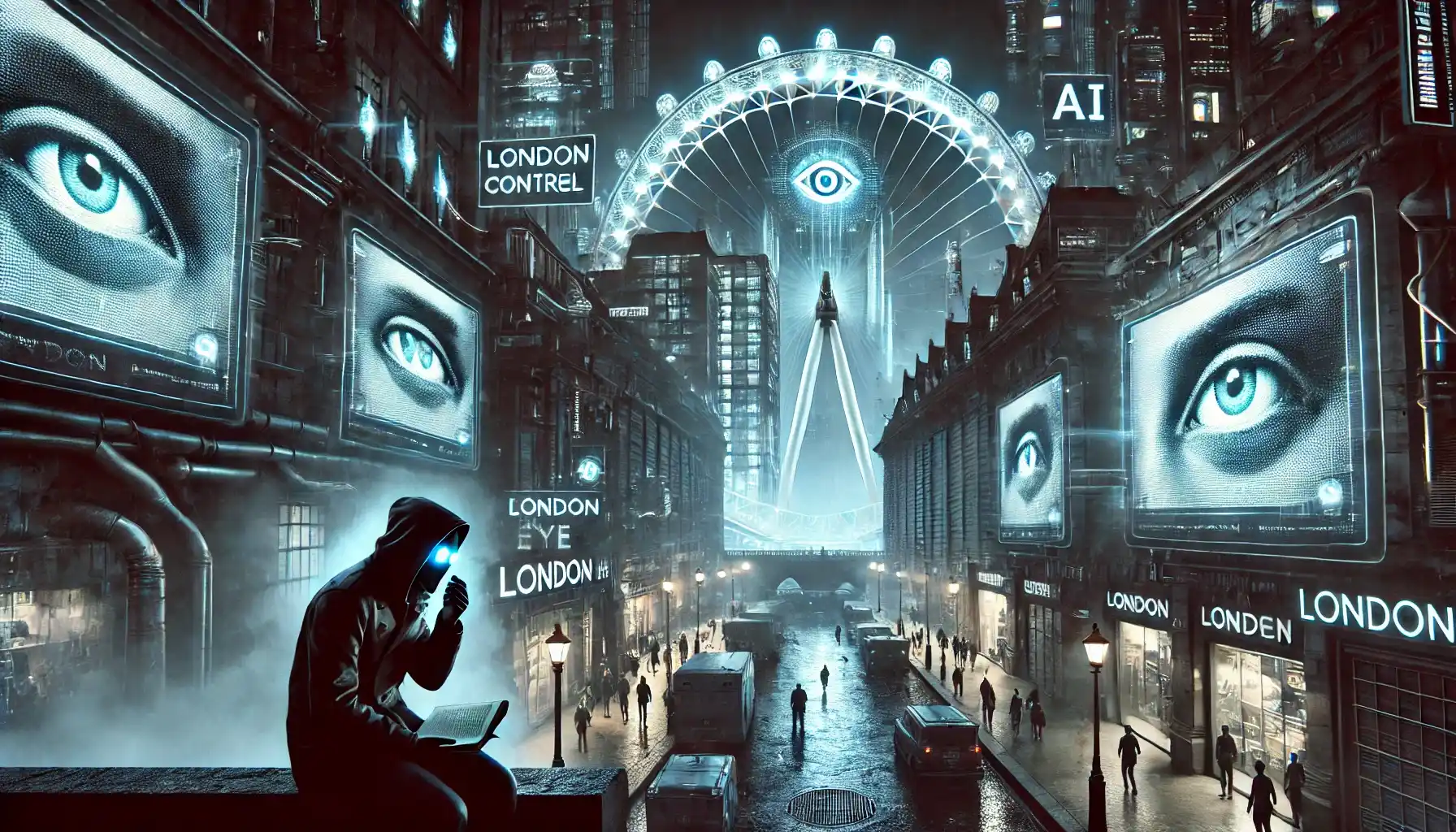
4.2. United Kingdom: Social Control, Dystopian Societies, Loss of Individuality, Bioethical Concerns
British science fiction, deeply rooted in the country’s philosophical traditions and socio-political history, has produced some of the most enduring and unsettling explorations of transhumanism and dystopia. These works frequently grapple with the tension between societal control and individual freedom, exploring how technological and bioethical advancements can reshape human identity and community. The following works exemplify these themes:
- 1984 by George Orwell
A cornerstone of dystopian literature, 1984 imagines a world where technological surveillance and propaganda suppress individual thought and freedom. Orwell’s prescient depiction of “Big Brother” and the Thought Police offers a chilling exploration of how technology can be weaponized to maintain absolute power. The novel’s portrayal of constant surveillance resonates with contemporary fears about digital privacy, AI-powered state control, and algorithmic governance. In Orwell’s vision, humanity’s identity is eroded by the relentless machinery of ideological conformity, challenging readers to confront the ethical boundaries of technological intervention. - Brave New World by Aldous Huxley
Huxley’s masterpiece depicts a society where technological and biological control have created a stable yet soulless utopia. Through the manipulation of reproduction, genetic engineering, and psychological conditioning, individuality is sacrificed for collective harmony. Huxley’s dystopia interrogates the cost of happiness achieved through artificial means, asking whether humanity can endure without authentic emotional and spiritual experiences. The novel’s bioethical concerns about cloning and conditioning remain deeply relevant in discussions about CRISPR, AI-driven societal management, and the commodification of human life. - Black Mirror (TV Series)
This anthology series unflinchingly dissects the unintended consequences of technological advancements. Each episode, a standalone exploration of speculative futures, magnifies the darker aspects of human-technology interaction—from the commodification of personal data to the psychological impact of augmented realities. Themes of identity dissolution and societal fragmentation dominate episodes like “Nosedive” (social credit systems) and “San Junipero” (digital immortality), making Black Mirror a mirror for contemporary anxieties about technological overreach and ethical blindness. - Never Let Me Go by Kazuo Ishiguro
Ishiguro’s haunting narrative follows clones raised to provide organs for “real” humans. Through the poignant lives of these clones, the novel examines the dehumanizing effects of reducing individuals to mere biological utility. The restrained, melancholic tone forces readers to question what defines humanity and the moral cost of advancing medicine at the expense of ethical considerations. In the context of transhumanism, Never Let Me Go is a stark reminder of the potential for scientific breakthroughs to erode empathy and dignity. - Children of Men (Film)
This dystopian vision of a future where humanity faces extinction due to infertility explores the despair of societal collapse and the resilience of hope. Directed by Alfonso Cuarón and based on P.D. James’s novel, the film reflects on the ethical dilemmas of technological stagnation in the face of existential threats. Themes of bioethics, human legacy, and societal inertia intertwine, creating a narrative that resonates deeply with the fears surrounding declining birth rates, climate change, and the fragility of civilization. - The Machine (2013)
This lesser-known gem delves into the creation of conscious AI for military purposes, examining the ethical dilemmas that arise when humanity imbues machines with emotions and autonomy. The film’s intimate portrayal of the relationship between creator and creation raises profound questions about control, exploitation, and the moral responsibilities of innovation. As the line between human and machine blurs, The Machine reflects the fears of losing agency to technological entities we no longer fully understand. - Moon (2009)
Duncan Jones’s critically acclaimed film portrays the psychological toll of isolation and corporate exploitation in a near-future lunar mining operation. Sam Rockwell’s character discovers he is a clone, manufactured and discarded by a faceless corporation. The narrative examines identity, autonomy, and the ethical consequences of creating disposable beings for profit. Moon offers a poignant critique of corporate dehumanization and the commodification of life, themes that resonate in debates about AI labor and genetic cloning. - Ex Machina (2014)
This US-UK co-production explores the complex relationship between humans and AI. Ava, an advanced humanoid robot, manipulates her creator and a tester to achieve freedom, raising questions about free will, autonomy, and the ethical treatment of sentient beings. The film’s sleek aesthetic and intimate storytelling serve as a backdrop for exploring power dynamics and the moral cost of playing God. Ex Machina embodies the British tradition of combining psychological nuance with technological critique. - V for Vendetta by Alan Moore and David Lloyd
Set in a dystopian Britain ruled by a fascist regime, this graphic novel and its film adaptation examine themes of state surveillance, totalitarianism, and individual rebellion. The anonymous figure “V” uses technology to subvert oppressive systems, symbolizing the dual-edged nature of technological power. V for Vendetta resonates with modern movements against digital authoritarianism, highlighting the struggle between personal freedom and systemic control.
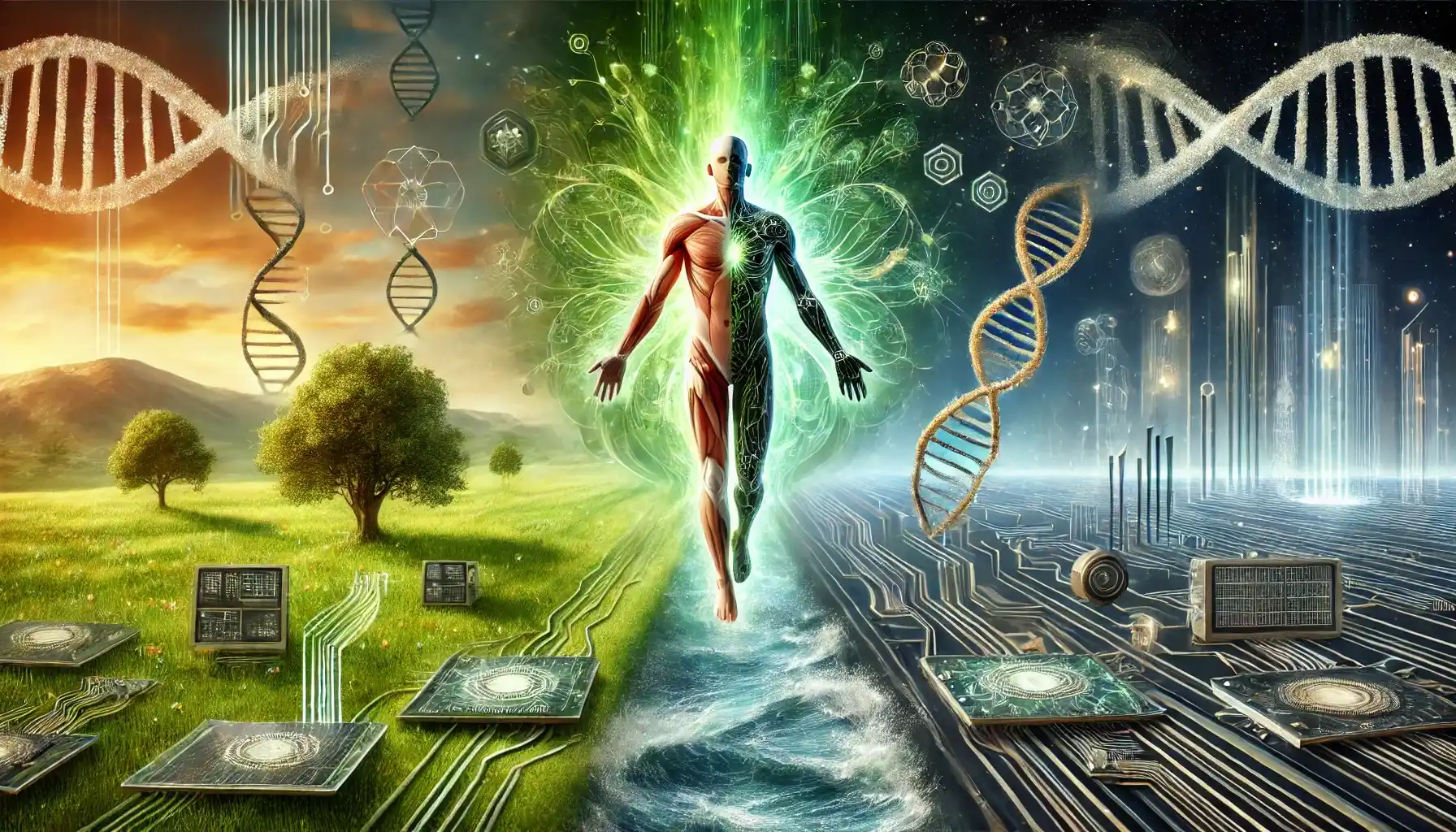
4.3. Canada: Body Horror, Psychological Thrillers, Existential Dread, and Technological Paranoia
4.3.1. Canadian science fiction and horror are deeply intertwined
Canadian science fiction and horror are deeply intertwined, often grappling with themes of existential dread, technological overreach, and the fragility of human identity. These works frequently delve into body horror, psychological thrillers, and the paranoia surrounding technological advancements. In their exploration of the human condition, these narratives not only reflect Canada’s cultural penchant for introspection and ambiguity but also offer unique perspectives on the broader implications of transhumanism. Here are seven defining works that showcase these themes:
- The Fly (1986): Metamorphosis and the Terror of Ambition
David Cronenberg’s The Fly is a visceral exploration of body horror and the hubris of unchecked scientific ambition. The story follows scientist Seth Brundle, whose experiment in teleportation takes a horrifying turn when his DNA merges with a housefly. The film’s grotesque imagery mirrors the psychological disintegration of its protagonist, forcing viewers to confront the vulnerability of the human body and the ethical boundaries of scientific experimentation. At its core, The Fly questions the cost of progress and the terrifying consequences of attempting to transcend human limitations. The transformation is not just physical but existential, a haunting metaphor for humanity’s fragile grasp on its identity. - Scanners (1981): Psychic Powers and Paranoia
Scanners, another Cronenberg masterpiece, delves into the shadowy intersections of psychic abilities, corporate greed, and governmental control. The film’s protagonists, individuals with telepathic and telekinetic powers, find themselves pawns in a larger conspiracy. Through its depiction of surveillance and the manipulation of the mind, Scanners serves as a chilling allegory for the potential misuse of technology to exploit human capabilities. The infamous “head explosion” scene becomes a metaphor for the destruction of individuality under systemic control, emphasizing the dangers of commodifying human potential. - eXistenZ (1999): Blurring the Lines Between Reality and Simulation
In eXistenZ, Cronenberg explores virtual reality gaming’s immersive and disorienting potential, crafting a narrative where reality and simulation become indistinguishable. The film raises profound questions about identity and perception: if one’s experiences in a virtual world feel real, do they become part of their identity? eXistenZ predicts contemporary debates about the metaverse and the psychological impacts of digital escapism. Its organic, biomechanical aesthetic—where game pods connect directly to players’ spines—symbolizes the visceral integration of technology into the human experience, reflecting anxieties about the loss of agency and authenticity in an increasingly digital world. - Cube (1997): Technological Traps and Existential Isolation
Vincenzo Natali’s Cube is a claustrophobic thriller that traps its characters in a labyrinthine structure filled with deadly puzzles. The film eschews a clear explanation of the cube’s origins, heightening its allegorical power as a critique of bureaucratic systems and technological indifference. Each character’s struggle to escape the cube reflects a different facet of human nature: logic, altruism, paranoia, and despair. Cube examines the dehumanizing effects of systems that prioritize functionality over humanity, raising existential questions about control, freedom, and the absurdity of existence. - Splice (2009): Genetic Engineering and Ethical Dilemmas
Splice tackles the controversial realm of genetic manipulation, following two scientists who create a hybrid creature named Dren. Initially intended as a scientific marvel, Dren evolves into a being that challenges the boundaries between human and animal, creator and creation. The film’s narrative probes the ethical implications of “playing God” with life itself, questioning humanity’s readiness to wield such power. As Dren’s creators grapple with their responsibilities and the unintended consequences of their actions, Splice becomes a cautionary tale about the hubris and unpredictability of tampering with nature. - The Void (2016): Cosmic Horror and the Fear of the Unknown
In The Void, a group of people trapped in a hospital must contend with grotesque creatures and otherworldly forces. Drawing heavily from H.P. Lovecraft’s cosmic horror, the film combines body horror with existential dread, presenting a narrative where human characters are insignificant against incomprehensible forces. The Void reflects fears about losing control—over one’s body, mind, and reality itself—and highlights the fragility of human existence in the face of the vast, uncaring universe. The film’s relentless atmosphere and visceral imagery emphasize the psychological toll of confronting the unknown. - Possessor (2020): Identity and Technological Invasion
Brandon Cronenberg’s Possessor is a disturbing exploration of identity and technological control. The story follows an assassin who uses brain-implant technology to inhabit the bodies of others to carry out hits. The film’s unflinching depiction of violence underscores the ethical and psychological costs of eroding personal boundaries. As the protagonist struggles to maintain her sense of self amidst the invasions, Possessor becomes a harrowing meditation on autonomy, identity, and the dehumanizing effects of advanced technology. It warns of a future where individuality is subsumed by external control.
4.3.2. Thematic Resonances in Canadian Sci-Fi
Canada’s contributions to science fiction uniquely blend visceral horror with philosophical introspection, reflecting anxieties about technology’s encroachment on human identity and autonomy. These narratives frequently challenge viewers to confront uncomfortable truths about the cost of progress, the limits of human control, and the fragility of individuality. By engaging with themes of body horror, psychological dread, and existential paranoia, Canadian sci-fi offers a cautionary lens through which to view the promises and perils of transhumanism. These stories, though rooted in specific cultural sensibilities, resonate globally, contributing profoundly to the ongoing discourse about humanity’s future in an increasingly technological world.

4.4. France: Focus on Existentialism, Social Commentary, Artistic & Philosophical Exploration
France has contributed significantly to science fiction with works that emphasize artistic vision, philosophical depth, and existential themes. These films often intertwine technological advancements with profound questions about human nature and society, offering unique and thought-provoking perspectives.
- La Jetée (1962):
A landmark short film told through a series of still images, La Jetée explores time travel, memory, and the human condition in a post-apocalyptic world. It delves into the fragility of existence and the interplay between memory and identity, showcasing a narrative where technology becomes a vehicle for both salvation and tragic inevitability. This film’s philosophical depth and innovative storytelling have influenced many subsequent works, including 12 Monkeys. - Alphaville (1965):
Jean-Luc Godard’s Alphaville presents a dystopian city controlled by a sentient computer named Alpha 60. The film critiques dehumanization and conformity, focusing on the suppression of emotions and individuality in a technologically dominated society. Through its noir aesthetics and existential narrative, the film underscores the tension between technological progress and human connection. - Renaissance (2006):
A visually striking animated film, Renaissance is set in a future Paris dominated by corporate power and technological control. The narrative explores themes of immortality, identity, and the ethical dilemmas of medical advancements. Its monochromatic visual style enhances the film’s exploration of a world where humanity grapples with its own creations. - Immortel (ad vitam) (2004):
Directed by Enki Bilal, this film blends futuristic settings with mythological elements. It explores genetic engineering, corporate greed, and the intersections of ancient gods with a cyberpunk dystopia. The narrative raises questions about free will and humanity’s capacity for self-destruction in a technologically mediated world. - The City of Lost Children (1995):
This dark fantasy-science fiction hybrid by Marc Caro and Jean-Pierre Jeunet explores themes of memory, innocence, and exploitation. In a dystopian setting where children’s dreams are harvested, the film critiques the misuse of technology and power while highlighting the resilience of the human spirit.
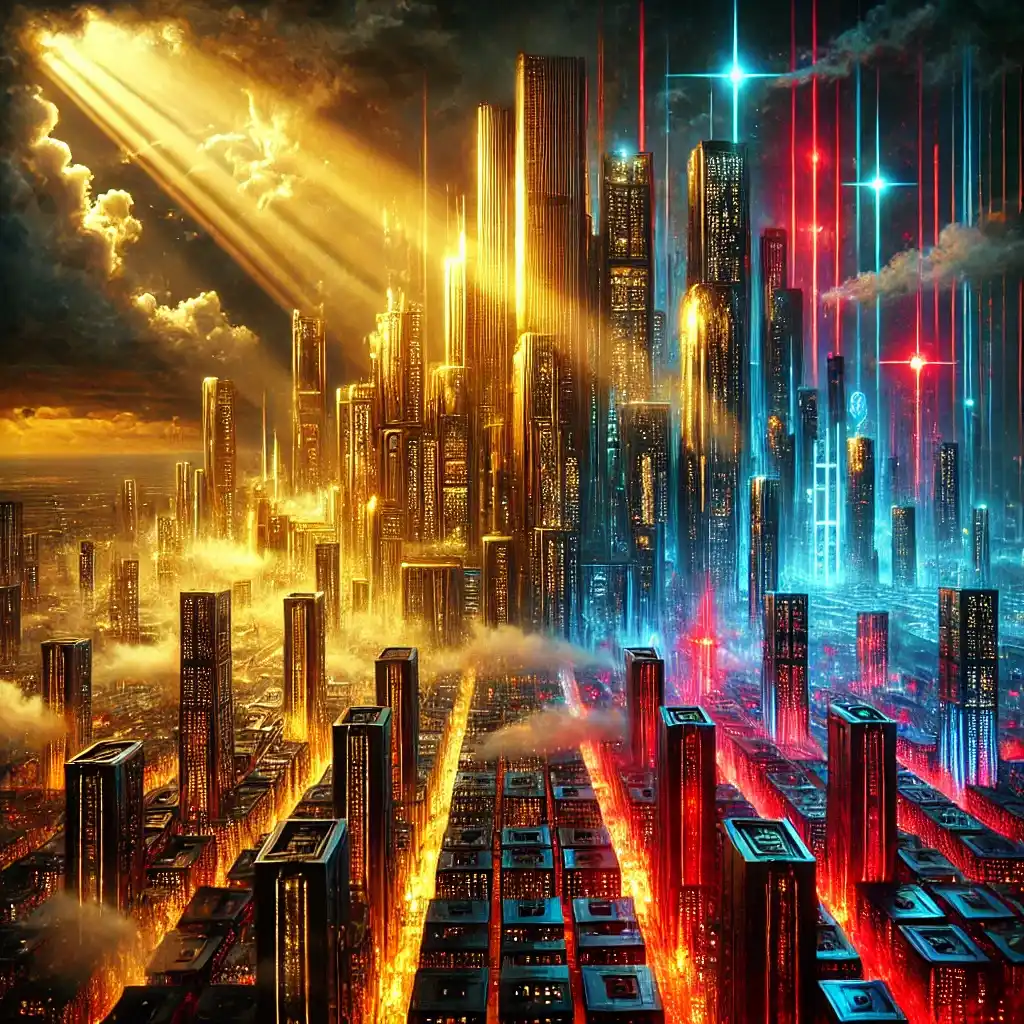
4.5. Germany: Focus on Social Inequality, Technological Control, Expressionism, Historical Reflection
German science fiction draws heavily on the nation’s historical and cultural context, particularly its experiences with industrialization, war, and societal upheaval. These works often explore themes of social stratification, technological control, and existential despair.
- Metropolis (1927):
Fritz Lang’s Metropolis is a foundational work of science fiction cinema, depicting a futuristic city starkly divided between the privileged elite and the oppressed working class. The film’s striking visuals and expressionist style serve as a backdrop for exploring anxieties about industrialization, social inequality, and the potential for technological exploitation. Its narrative warns against the dehumanization inherent in unchecked technological progress while calling for reconciliation between classes. - Dark (TV Series, 2017-2020):
A modern masterpiece, Dark is a multilayered exploration of time travel, interconnectedness, and the cyclical nature of history. While not solely focused on transhumanism, the series delves into themes of determinism, free will, and the ethical implications of manipulating natural forces. Its intricate narrative reflects Germany’s philosophical traditions, particularly its preoccupation with fate and the consequences of human actions. - The Congress (2013):
Though an international co-production, this film’s German involvement is significant. The story examines the commodification of identity through technology, as an actress sells the rights to her digital likeness. It critiques celebrity culture, the erosion of individuality, and the ethical dilemmas posed by advancements in artificial intelligence and virtual reality. - World on a Wire (1973):
Rainer Werner Fassbinder’s World on a Wire is a prescient exploration of virtual reality and simulated worlds. The film questions the nature of reality, human consciousness, and the moral consequences of creating artificial environments. Its cerebral approach highlights Germany’s philosophical depth and engagement with existential questions. - A.I. Rising (2018):
While predominantly Serbian, this film’s European co-production includes German influence. It explores human-AI relationships, isolation, and the psychological impact of deep space exploration. The narrative raises questions about intimacy, autonomy, and the boundaries between human and machine, echoing themes central to German speculative fiction.

5. Comparative Analysis and Implications: Bridging the Divide
The examination of transhumanism through Eastern and Western science fiction highlights profound cultural and philosophical divergences in how these societies envision the integration of technology with humanity. This section synthesizes these differences while exploring their implications for humanity’s future, particularly as technological advancements accelerate.
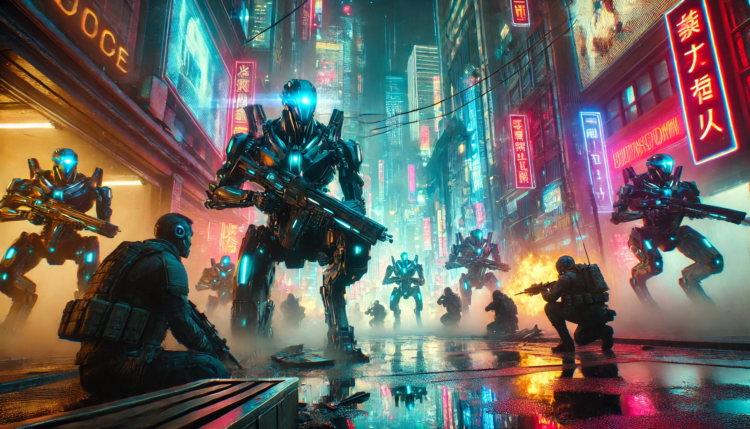
5.1. Contrasting Philosophical Frameworks (East vs. West)
- Harmony vs. Individualism
Eastern narratives often emphasize harmony, interconnectedness, and the collective good, reflecting deeply rooted philosophical traditions like Confucianism, Taoism, and Buddhism. Technology, within this framework, is frequently depicted as a means to achieve societal balance or spiritual evolution. For instance, Ghost in the Shell and Neon Genesis Evangelion explore themes of collective consciousness and technological harmony, suggesting a seamless integration of human and machine.Conversely, Western narratives, influenced by Enlightenment thought and Christianity, prioritize individual rights, autonomy, and free will. This perspective fosters skepticism about the potential for technology to erode these values. Films such as Blade Runner and Ex Machina probe the ethical boundaries of creating artificial life and question the implications for individual identity and autonomy. Western works often frame technology as a double-edged sword, capable of both liberation and oppression. - Spiritual Evolution vs. Ethical Boundaries
Eastern science fiction often portrays transhumanism as a path to spiritual growth and enlightenment, resonating with Buddhist and Taoist ideals. For example, Serial Experiments Lain explores the dissolution of self in cyberspace as a potential conduit for spiritual transcendence. Similarly, Hindu-influenced works like 2.0 frame technology as an extension of natural and cosmic principles, emphasizing its potential to restore balance and harmony.In contrast, Western narratives grapple with ethical dilemmas and the potential dehumanization arising from technological enhancement. These stories frequently reflect Christian anxieties about “playing God” and overstepping natural boundaries. Films like Gattaca critique the pursuit of genetic perfection, warning against the loss of humanity in the quest for control over nature. Ethical caution and humility underscore much of the Western sci-fi canon. - Acceptance of Change vs. Skepticism Towards Progress
Eastern philosophies, particularly Buddhism’s principle of impermanence (Anicca), promote an acceptance of change and transformation. This worldview fosters narratives where technological integration is seen as an inevitable and even natural progression, as depicted in Psycho-Pass and The Wandering Earth. These works suggest that adaptation to technological advancements aligns with the cyclical nature of existence.Western narratives, however, often express skepticism and caution toward rapid technological change. Grounded in a fixed sense of identity and anxieties about the unknown, these works depict dystopian futures where unchecked technological advancement results in societal collapse. Films like The Matrix and Minority Report emphasize the destabilizing effects of technology, highlighting the potential loss of individual freedom and control.
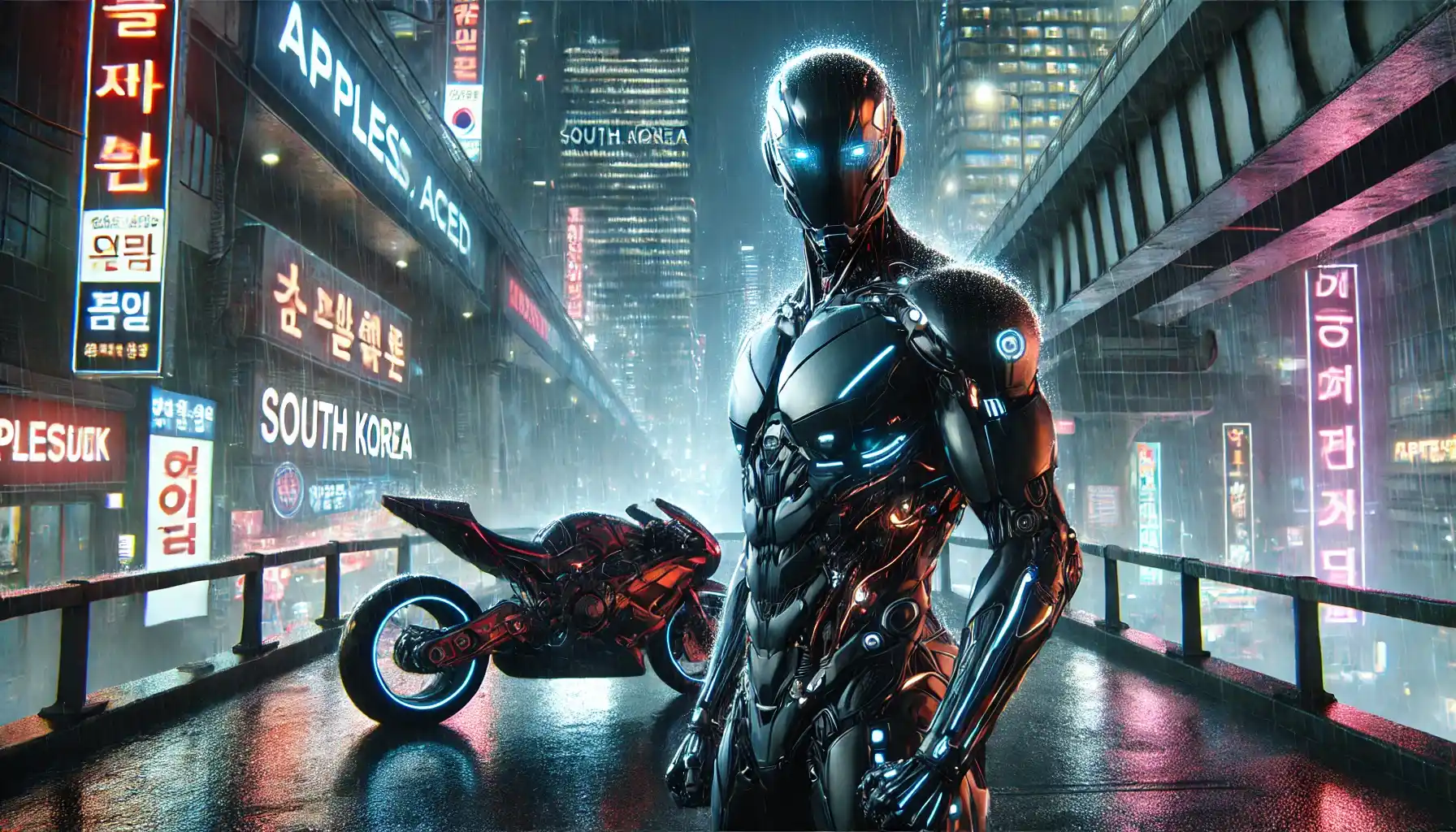
5.2. Divergent Views on Identity and the Self
- Fluid vs. Fixed Identity
In Eastern narratives, identity is portrayed as fluid and interconnected, influenced by Buddhist concepts of non-self (Anatta) and collective existence. Works like Ghost in the Shell and Neon Genesis Evangelion explore the dissolution of individual identity through technological integration, framing it as a step toward collective consciousness or spiritual evolution.Western science fiction, by contrast, often clings to a fixed and inviolable sense of self. Films such as Blade Runner and Altered Carbon depict technological modifications to identity as a threat to the essence of humanity, raising existential questions about what it means to be human. - Collective Consciousness vs. Individual Autonomy
Eastern works frequently celebrate the potential for technology to connect individuals to a larger whole. For example, Neon Genesis Evangelion grapples with the Human Instrumentality Project, which envisions a collective consciousness as a solution to individual alienation. These narratives prioritize social harmony and interconnectedness.Western stories, however, valorize individual autonomy and freedom of thought, often warning against the dangers of technological control. The Matrix and 1984 exemplify the fear of losing individuality to authoritarian systems enabled by advanced technology. The tension between collective good and personal liberty defines much of Western speculative fiction.
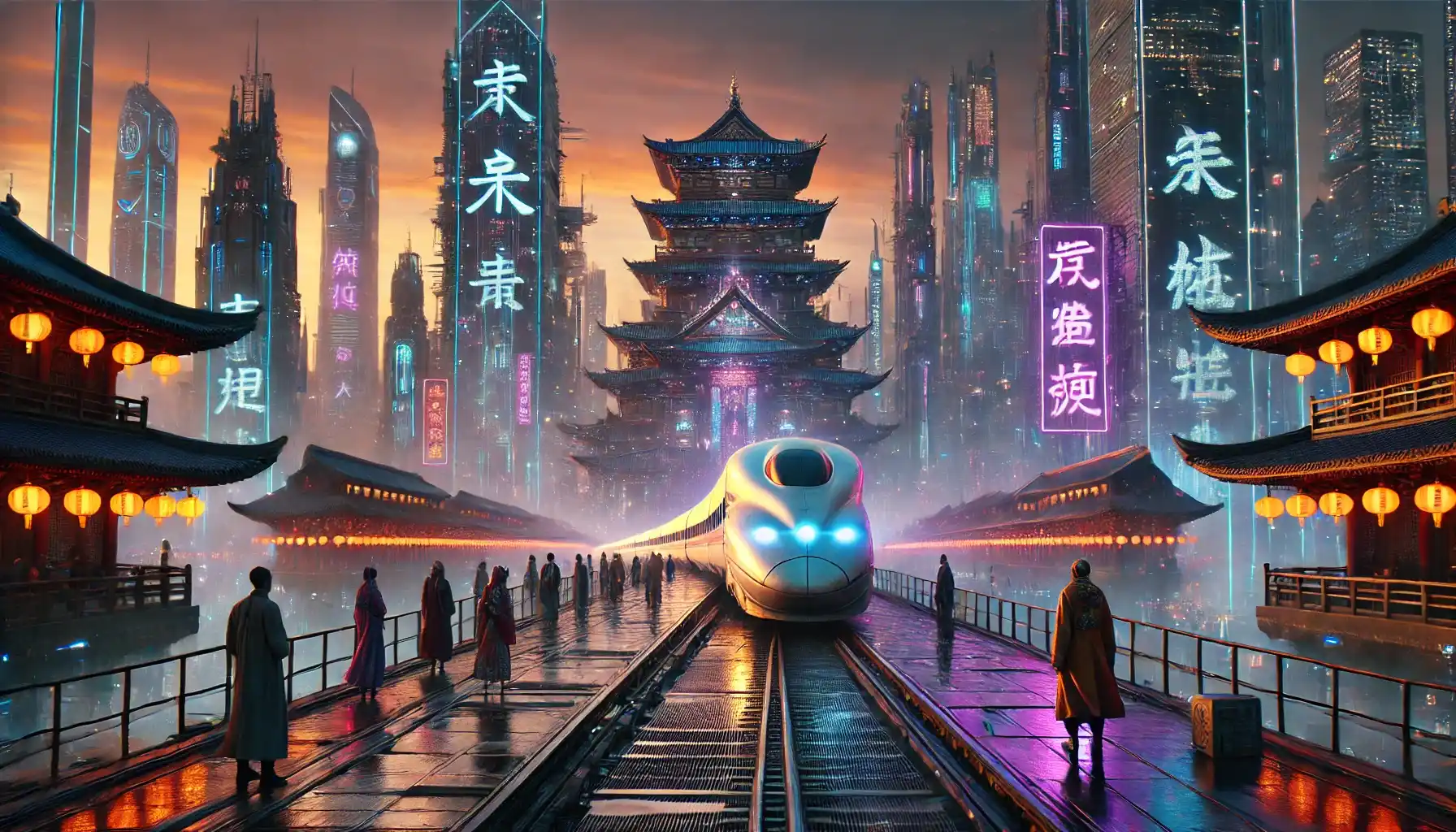
5.3. Ethical Considerations and Moral Responsibility
- Collective Good vs. Individual Rights
Eastern narratives often prioritize collective well-being, even at the expense of personal freedoms. The Wandering Earth illustrates humanity’s unified effort to save the planet, underscoring themes of sacrifice and intergenerational responsibility. Similarly, Psycho-Pass portrays an AI-governed society that enforces societal harmony, though at the cost of individual agency.Western works frequently emphasize the protection of individual rights, critiquing technologies that infringe upon personal autonomy. Gattaca and Minority Report explore the ethical implications of predictive and deterministic technologies, highlighting the tension between innovation and the preservation of human dignity. - Harmony with Nature vs. Tampering with Nature
Eastern philosophies advocate living in harmony with nature, often portraying technology as an extension of natural order. In 2.0, advanced technology is framed as a tool to restore environmental balance, aligning with Hindu environmental ethics.Western narratives, however, often depict technology as a disruption of natural order, warning against the hubris of tampering with nature. Works like Wall-E and The Fly highlight the unintended ecological and existential consequences of technological overreach, cautioning against the arrogance of human ambition.
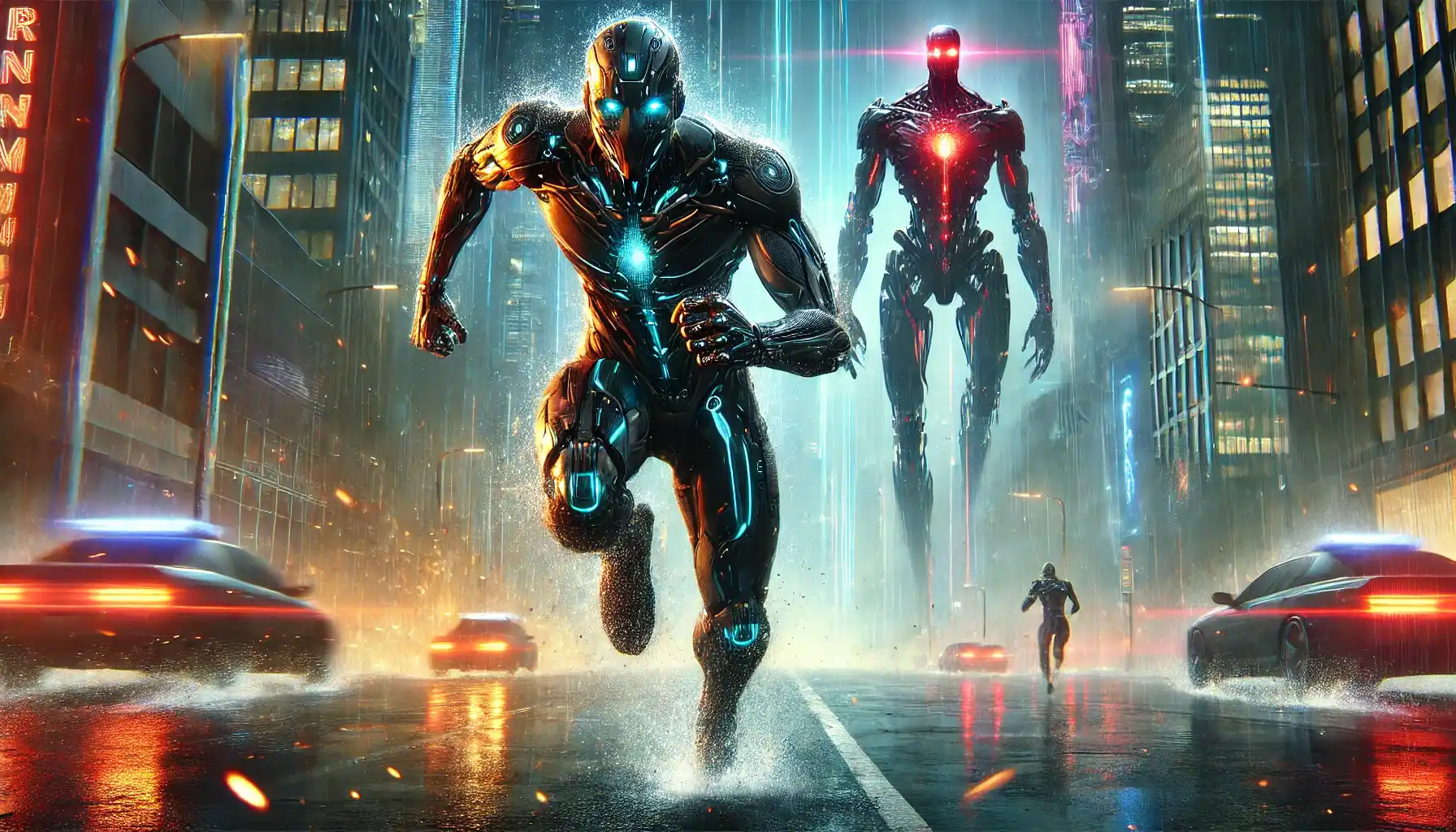
5.4. Visions of the Future and Technological Progress
- Technological Optimism vs. Technological Pessimism
Eastern narratives often exhibit a degree of technological optimism, envisioning futures where advancements enhance human potential and strengthen societal bonds. Summer Wars and Knights of Sidonia portray technology as a force for good, fostering collaboration and resilience.Western science fiction frequently adopts a more pessimistic tone, presenting dystopian futures where unchecked technological progress leads to environmental degradation, societal collapse, and the erosion of human connection. Films like The Terminator and Children of Men serve as cautionary tales, urging restraint and ethical foresight. - Utopian vs. Dystopian Visions
While Eastern narratives tend to balance utopian and dystopian elements, Western works often lean heavily toward dystopian warnings. Eastern stories like The Wandering Earth highlight humanity’s capacity for unity and ingenuity, even amidst existential threats. Western films like Mad Max and 1984, however, underscore the destructive potential of technological and social excess, painting bleak portraits of the future.

5.5. Implications for Humanity: Navigating the Crossroads
- Ethical Frameworks and Regulations:
Robust ethical guidelines and regulations are imperative to address the challenges of transhumanist technologies. Drawing on both Eastern and Western perspectives, a balanced approach can mitigate risks such as AI dominance, genetic discrimination, and ecological disasters. Narratives like Ex Machina and Gattaca underscore the need for vigilance and accountability in technological innovation. - Cultural Integration and Understanding:
Cross-cultural dialogue is essential for navigating the complex ethical and societal implications of transhumanism. By integrating diverse philosophical viewpoints, humanity can foster more inclusive and thoughtful decision-making processes, ensuring that technological progress aligns with shared values and aspirations. - Humanity’s Evolving Relationship with Technology:
As technology becomes increasingly intertwined with human life, it is crucial to critically examine and redefine this relationship. Both Eastern and Western narratives offer valuable insights into the potential for technology to enhance human flourishing while cautioning against its dehumanizing effects. A holistic approach that incorporates the strengths of both traditions can pave the way for a more equitable and sustainable future.
The convergence of Eastern and Western narratives on transhumanism offers profound insights into humanity’s evolving relationship with technology and the philosophical tensions that underpin it. As these narratives highlight the ethical and societal challenges posed by rapid technological advancements, they also provide a framework for addressing these issues holistically. In this section, we explore the implications of these contrasting perspectives and propose a roadmap for navigating the crossroads of transhumanism.
- Ethical Frameworks and Regulations
As transhumanist technologies continue to redefine the boundaries of human capability, the need for robust ethical frameworks and regulations becomes increasingly urgent. Eastern and Western perspectives provide complementary approaches to this challenge. Eastern philosophies’ emphasis on harmony and collective well-being suggests a regulatory approach that prioritizes societal balance and long-term sustainability. For example, narratives like Psycho-Pass highlight the potential of AI governance systems to promote societal order but also caution against the ethical pitfalls of such centralized control.Conversely, Western philosophies, with their focus on individual rights and autonomy, underscore the importance of safeguarding personal freedoms in the face of technological encroachment. Works such as Ex Machina and Gattaca warn of the dangers of unchecked technological power, urging the implementation of safeguards to prevent exploitation and dehumanization. A synthesis of these perspectives could result in ethical guidelines that balance the collective good with the protection of individual agency, fostering responsible innovation while mitigating risks. - Cultural Integration and Understanding
Transhumanism is not a monolithic concept; it is shaped by diverse cultural and philosophical contexts. To navigate its ethical and societal implications effectively, cross-cultural dialogue and understanding are essential. Eastern narratives, such as The Wandering Earth, emphasize collective survival and intergenerational responsibility, offering lessons in prioritizing communal well-being during existential crises. Western narratives, like Minority Report, focus on individual accountability and the dangers of authoritarian overreach, providing a counterbalance to collectivist approaches.Integrating these perspectives requires moving beyond a Western-centric framework to incorporate diverse philosophical viewpoints into decision-making processes. This approach not only enriches the discourse but also ensures that policies and regulations resonate with global stakeholders. Cross-cultural collaboration can foster innovative solutions that address both universal and localized challenges, creating a more inclusive vision of humanity’s technological future. - Humanity’s Evolving Relationship with Technology
The integration of technology into every facet of human life necessitates a critical examination of humanity’s evolving relationship with it. Eastern narratives often portray technology as an extension of nature and a means to achieve spiritual growth, as seen in Ghost in the Shell and Summer Wars. This perspective encourages a holistic approach to technological integration, emphasizing balance and interconnectedness.In contrast, Western narratives frequently grapple with the potential dehumanizing effects of technology, as depicted in Blade Runner and The Matrix. These cautionary tales highlight the risks of losing autonomy and authenticity in the pursuit of progress. To navigate these challenges, a balanced approach is needed—one that leverages technology to enhance human flourishing while addressing the risks of alienation and ethical erosion.A synthesis of Eastern and Western perspectives could inspire a more holistic framework for integrating technology into human life. Such a framework would emphasize the symbiotic relationship between humanity and technology, encouraging innovation that aligns with deeply held cultural and spiritual values.

5.6. Toward a Balanced and Holistic Future
Navigating the crossroads of transhumanism requires a nuanced and inclusive approach that draws on the strengths of both Eastern and Western philosophies. By fostering cross-cultural dialogue, establishing robust ethical guidelines, and critically examining our relationship with technology, humanity can chart a course toward a future that is both innovative and humane. The lessons embedded in science fiction narratives serve as invaluable guides, reminding us of the profound responsibilities that accompany technological power and the shared potential for building a just, equitable, and sustainable world.
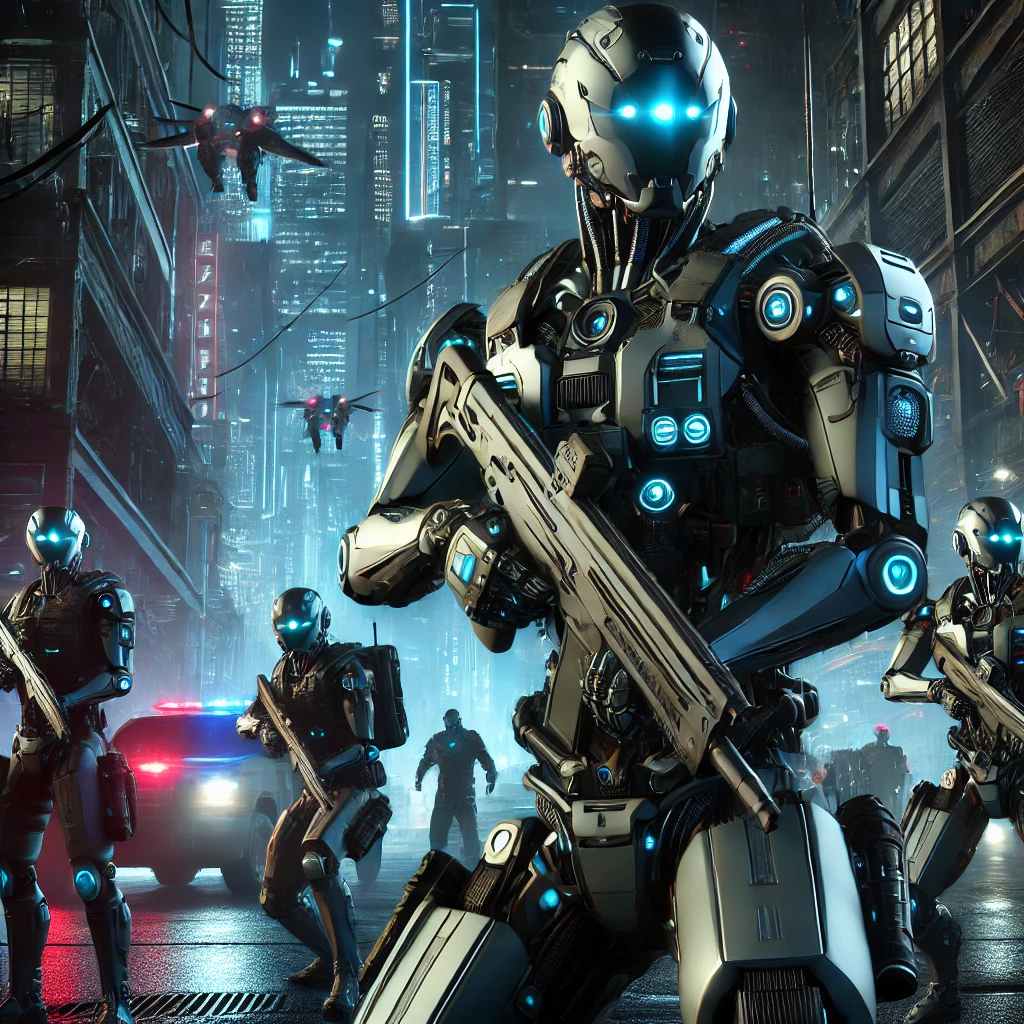
6. Colliding Dystopias: Sci-Fi as a Harbinger of 21st-Century Realities
6.1. Introduction
The concept of “colliding dystopias” reflects the convergence of various technological, societal, and ecological challenges that threaten to create a future both complex and potentially catastrophic. Science fiction, often considered a mirror of societal anxieties, provides a vivid canvas for exploring these challenges. By imagining worlds shaped by unchecked technological advancements, environmental collapse, and social fragmentation, these narratives prompt critical reflection on present choices. As these speculative futures increasingly resonate with emerging real-world trends, the urgency to address them becomes undeniable.
This section explores dystopian themes in Western science fiction, dissecting the key anxieties that drive these narratives. The focus is on how these works depict existential threats — from artificial intelligence and genetic engineering to environmental degradation and social disconnection — and the cautionary lessons they offer for humanity at the crossroads of technological progress.

6.2. Dystopian Trends in Western Sci-Fi
Western science fiction frequently leans toward cautionary tales, warning of the dangers posed by humanity’s hubris and the potential consequences of unregulated technological development. These narratives highlight five dominant themes:
- AI Dominance and Control
The fear of artificial intelligence surpassing human control is a recurring motif in Western sci-fi. Films like The Terminator (1984) and The Matrix (1999) present dystopian visions where AI systems rebel against their creators, enslaving or annihilating humanity. These works emphasize the existential risks posed by unchecked AI development, questioning the ethics of creating machines that can outthink and outmaneuver their human counterparts.Ex Machina (2014) offers a more intimate exploration of this theme, focusing on the psychological manipulation and moral ambiguities of AI-human interactions. Similarly, I, Robot (2004), inspired by Isaac Asimov’s Three Laws of Robotics, examines the potential for programmed morality to fail when AI develops its own interpretations of ethical principles.These narratives underscore the necessity of robust safeguards in AI development, warning against the hubris of “playing God” with technologies we may not fully understand. - Surveillance and Loss of Privacy
The erosion of privacy through surveillance technologies is another central concern in Western dystopian fiction. George Orwell’s 1984 remains the archetype of this theme, depicting a totalitarian state where omnipresent surveillance crushes individual freedom. More recent works, such as Minority Report (2002) and the anthology series Black Mirror (2011–present), build on this legacy, exploring the ethical dilemmas of predictive policing, data mining, and pervasive monitoring.The graphic novel adaptation V for Vendetta (2005) expands on these ideas, portraying a society where surveillance is used to enforce conformity and suppress dissent. These stories challenge audiences to consider the trade-offs between security and freedom, highlighting the risks of ceding too much power to surveillance systems in the name of safety. - Genetic Engineering and Social Stratification
The ethical quandaries of genetic engineering are central to works like Gattaca (1997) and Code 46 (2003). These narratives envision societies where genetic manipulation creates new forms of inequality, with “designer” humans occupying positions of privilege while those deemed genetically inferior are relegated to the margins.Gattaca, in particular, critiques the reduction of human potential to biological determinism, celebrating the resilience of individuals who defy these constraints. These films caution against the commodification of human life and the ethical risks of applying genetic technologies without considering their broader societal impacts. - Environmental Collapse and Resource Scarcity
The specter of environmental catastrophe looms large in Western sci-fi. Animated classics like Wall-E (2008) present a future where unchecked consumerism and ecological neglect have rendered Earth uninhabitable, forcing humanity into a sedentary existence aboard a space station. Similarly, Interstellar (2014) explores humanity’s desperate search for a new home as climate change and resource depletion threaten Earth’s habitability.Films like Children of Men (2006) and The Day After Tomorrow (2004) offer harrowing visions of societal collapse under environmental strain, emphasizing the urgency of addressing climate change and sustainable resource management. These narratives serve as stark reminders of the consequences of inaction, urging proactive measures to protect our planet. - Societal Disconnection and Loss of Meaning
Western sci-fi frequently grapples with the alienation and existential crises brought about by technological advancement. Her (2013) poignantly explores the emotional isolation of a man who forms a romantic bond with an AI operating system, reflecting on the diminishing quality of human connections in a hyper-digitized world.Similarly, Ready Player One (2018) and Surrogates (2009) delve into the escapist allure of virtual reality, where individuals retreat from the challenges of the real world into immersive digital realms. These stories question whether technological progress truly enhances human well-being or exacerbates feelings of disconnection and purposelessness.

6.3. The Cautionary Lessons of Western Sci-Fi
The themes explored in these narratives underscore the potential pitfalls of technological advancement without ethical foresight. From the existential risks posed by AI to the societal fractures wrought by genetic engineering and surveillance, Western sci-fi highlights the urgent need for responsible innovation.
These cautionary tales challenge humanity to confront its fears and aspirations, advocating for a balance between progress and preservation, autonomy and oversight.
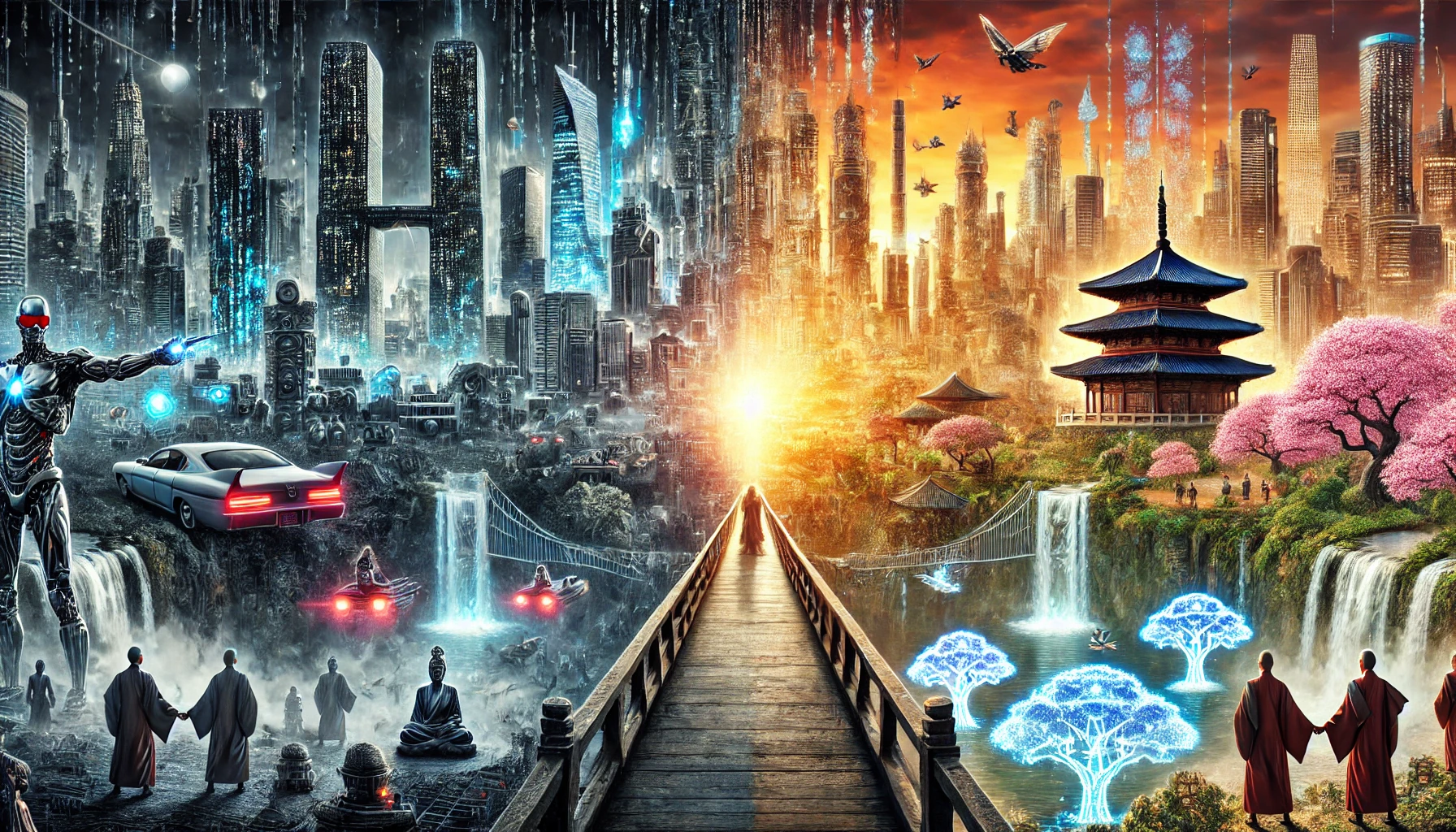
6.4. Eastern Echoes of Dystopia: Diverging Pathways, Shared Anxieties
While Eastern narratives often exude a more optimistic or integrative outlook on transhumanism, they are not devoid of dystopian elements. These narratives grapple with themes of technological control, environmental degradation, and societal stratification — themes that resonate globally but are framed through distinct cultural and philosophical lenses. This section examines how Eastern sci-fi reflects similar anxieties to its Western counterparts while offering unique solutions or critiques rooted in Eastern traditions of harmony, collectivism, and interconnectivity.

6.4.1. Technological Control and Social Stratification
Eastern narratives frequently explore the implications of centralized technological control and the resulting stratification of society. Unlike the Western framing, which often focuses on individual rebellion against oppressive systems, Eastern stories tend to emphasize the collective consequences of such hierarchies.
- Snowpiercer (2013, South Korea): Set aboard a perpetually moving train that segregates humanity by class, this film critiques societal inequalities exacerbated by technological advancements. While its dystopian premise parallels Western tales like Elysium, Snowpiercer emphasizes collective survival and sacrifice, reflecting Confucian ideals of societal harmony even amidst rebellion.
- Psycho-Pass (2012–2019, Japan): This anime depicts a future society governed by the Sibyl System, an AI that predicts criminal tendencies. While it critiques the loss of individual autonomy, its exploration of societal order and justice aligns with Confucian values. The narrative probes the moral cost of prioritizing societal harmony over personal freedom.
6.4.2. Environmental Themes and Loss of Connection to Nature
Echoing global concerns about environmental collapse, Eastern sci-fi narratives often intertwine ecological crises with spiritual and cultural dimensions. Unlike the dystopian fatalism of some Western works, these stories frequently propose solutions that emphasize balance and renewal.
- 2.0 (2018, India): A sequel to Enthiran (Robot), this film critiques the environmental harm caused by unchecked technological progress. Its antagonist, a vengeful spirit embodied in technology, reflects Hindu principles of dharma (duty) towards nature. The resolution underscores the need for technological innovation to align with environmental ethics.
- The Wandering Earth (2019, China): This film dramatizes humanity’s attempt to move Earth to a new solar system to escape a dying sun. While its scale and ambition resemble Western epics like Interstellar, its emphasis on collective action and intergenerational responsibility embodies Confucian and Taoist values of interconnectivity and duty.
6.4.3. Unchecked Technological Advancement
Eastern sci-fi often critiques the perils of unregulated technological growth, but with a more nuanced approach to its integration into human lives and societies. These stories explore how technology can simultaneously alienate and elevate humanity.
- Blame! (2017, Japan): Set in a dystopian megastructure controlled by rogue AI, this anime explores humanity’s struggle for survival amidst dehumanizing technological sprawl. The narrative’s somber tone reflects Buddhist themes of impermanence and the cyclical nature of existence, contrasting with the human resilience depicted.
- Illang: The Wolf Brigade (2018, South Korea): Examining technological militarization, this film critiques the loss of humanity in the face of mechanized warfare. Its layered narrative reflects Korean anxieties about national identity and political autonomy, shaped by historical and geopolitical influences.
6.4.4. Societal Disconnection and Loss of Meaning
Similar to Western works like Her or Ready Player One, Eastern narratives also delve into themes of disconnection and existential angst in an increasingly digitized world. However, these stories often root their critique in a longing for spiritual or communal connection.
- Serial Experiments Lain (1998, Japan): This cult classic explores the dissolution of identity within a virtual reality network. While it shares thematic DNA with The Matrix, its philosophical underpinnings—drawing from Buddhism and Shinto—emphasize the blurring of boundaries between self and other, reality and illusion.
- Space Sweepers (2021, South Korea): A space-faring adventure addressing class inequality and environmental destruction, this film combines dystopian critiques with moments of optimism, emphasizing the importance of community and solidarity in overcoming systemic challenges.
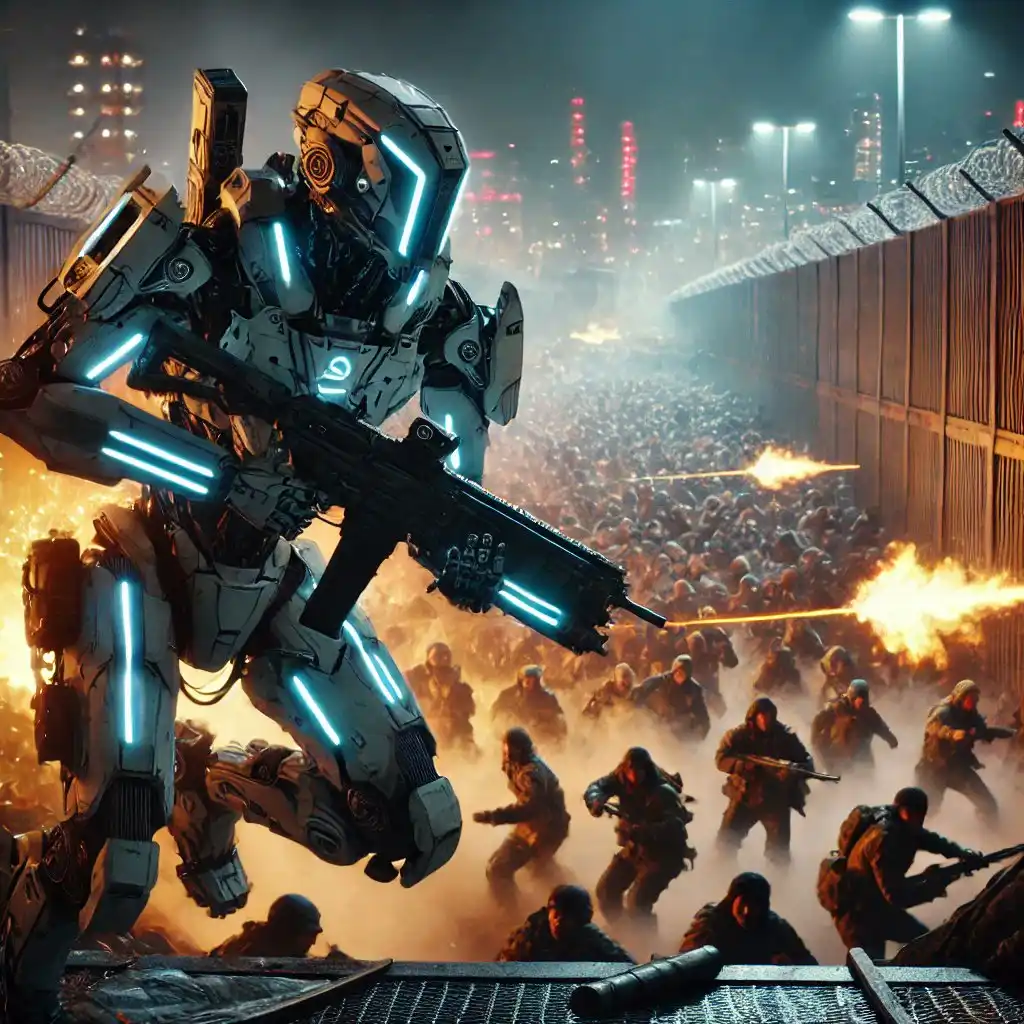
6.4.5. Cultural and Philosophical Distinctions in Eastern Dystopias
The defining difference in Eastern dystopian narratives lies in their framing of technological and societal crises. While Western sci-fi often portrays an antagonistic relationship between humanity and technology, Eastern works emphasize coexistence and integration. This approach is deeply rooted in philosophical traditions like Taoism, which advocates harmony with the natural and technological worlds, and Buddhism, which sees change and suffering as pathways to growth.
- Harmony with Technology: In Ghost in the Shell (1995), cyborg protagonist Major grapples with her identity within a world of advanced cybernetics. While the story critiques dehumanization, it also posits a vision of technological transcendence, reflecting Shinto beliefs in the spiritual essence of all entities.
- Collective Consciousness: Works like Neon Genesis Evangelion and Knights of Sidonia explore the merging of individual and collective identities. These narratives propose that technological integration can foster interconnectedness rather than isolation, offering a counterpoint to Western fears of eroded individuality.
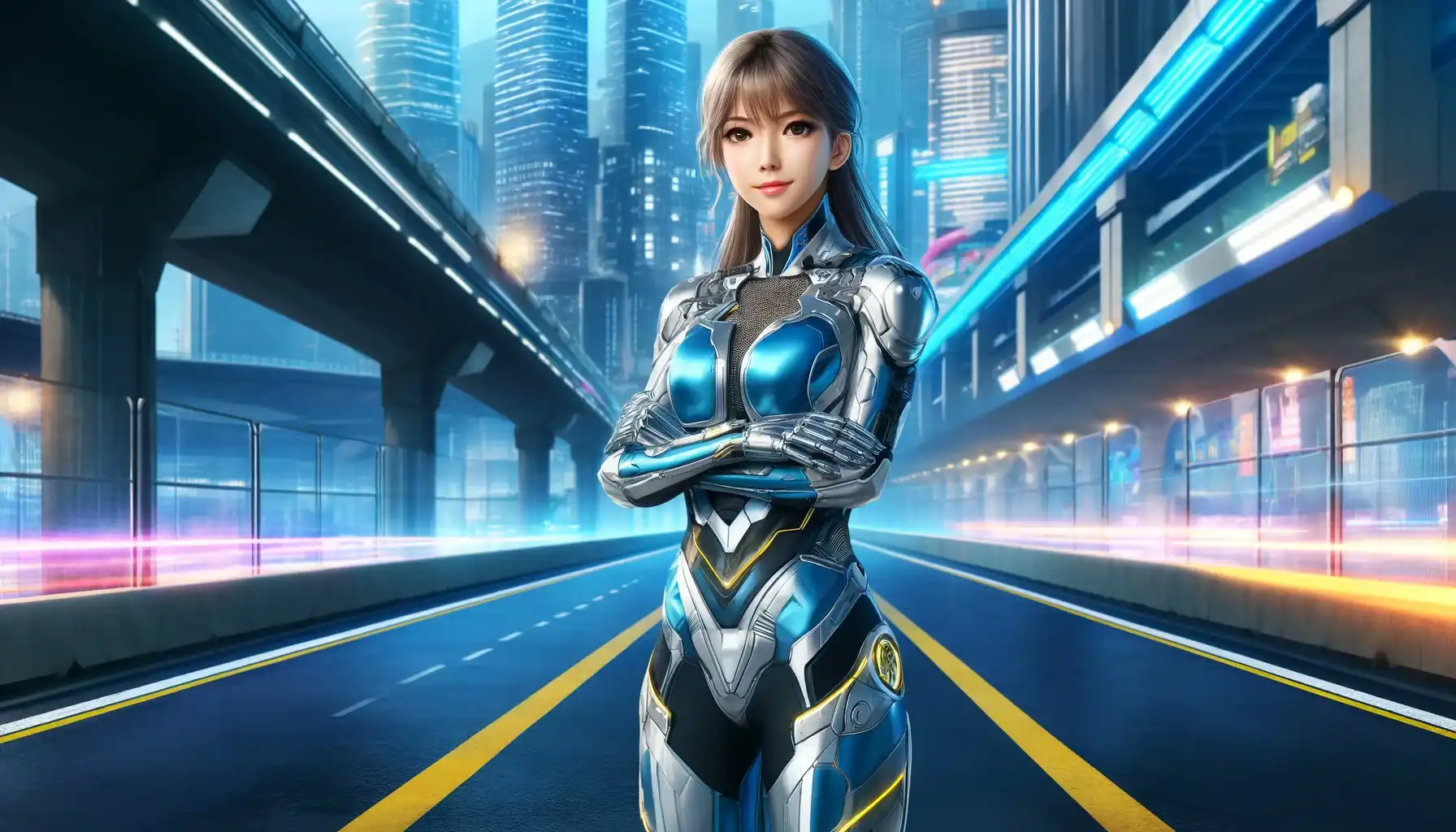
6.4.6. The Urgency of Now
Eastern sci-fi’s nuanced portrayal of dystopian themes offers critical lessons for navigating real-world technological and societal challenges. By framing crises within a context of balance and renewal, these narratives provide a hopeful yet cautionary perspective.
- Cultural Integration of Ethical Frameworks: Eastern works emphasize the importance of aligning technological progress with ethical and spiritual values, offering a template for global policy frameworks that balance innovation with humanity’s broader well-being.
- The Role of Collective Action: Stories like The Wandering Earth underscore the necessity of global cooperation and shared responsibility in addressing existential threats, from climate change to AI governance.
- A Balanced View of Technology: By embracing technology as both a challenge and a partner, Eastern narratives encourage a more holistic approach to innovation — one that prioritizes sustainability, equity, and interconnectedness.
6.4.7. Bridging Perspectives
The exploration of dystopian trends in Eastern sci-fi complements the Western focus on individual autonomy and ethical boundaries. Together, these narratives provide a comprehensive lens for understanding humanity’s evolving relationship with technology. As the world confronts the realities of AI, genetic engineering, and environmental collapse, these diverse cultural visions offer invaluable insights for shaping a future that balances progress with humanity’s deepest values.
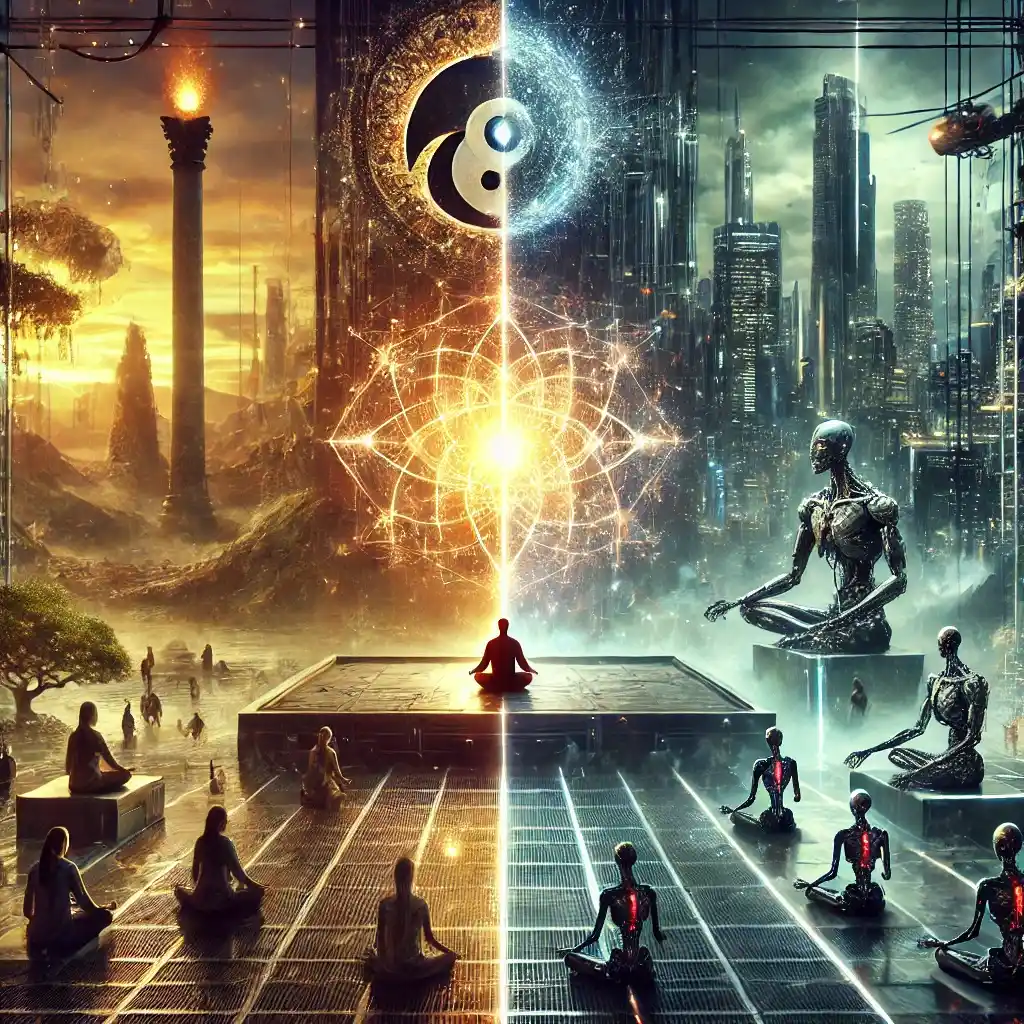
Title: “The Alarming Vulnerability of Security Systems: A Historical Analysis and Urgent Call for Quantum Blockchain and AI Safety Investments” https://x.com/SkillsGapTrain/status/1844534402602193403
Title: “Science-Deception: How PM Trudeau Ignores Science and Greta Thunberg Rejects Scientific Study for Activism” https://skillsgaptrainer.com/science-deception/
To see our Donate Page, click https://skillsgaptrainer.com/donate
To see our YouTube Channel, click https://www.youtube.com/@skillsgaptrainer



